In the fast-paced arena of mobile app development, two strong app development options emerge: web apps and native apps. When creating captivating digital experiences, it’s essential to grasp the advantages of web apps and native apps as well. Welcome to our blog and learn everything about the web app vs. native app landscape, where we’ll delve into the realms of web app development and cross-platform app development.
Web apps are the versatile single solution for all the problems of the tech world, as they are accessible across various platforms and the benefits they offer users and developers alike. On the other hand, native apps have their own unique advantages like seamless app performance and customized user experiences.
In this blog, we’ll take you on the journey of the ever-evolving world of app development, comparing the strengths of web apps to the advantages that native apps provide. By the journey’s end, you’ll possess a clear roadmap to help you chart the best course for your digital ambitions. So, let’s set sail on this enlightening adventure into the realm of web and native apps.
THE STRENGTHS OF NATIVE APPS
In the dynamic world of mobile applications, native apps stand tall with a host of unique benefits. Let’s delve into the remarkable strengths that make native apps a formidable force in the app development arena.
Superior Performance and Speed:
Native apps are like finely tuned sports cars on the digital highway. They are crafted to harness the full potential of the device they run on, offering unmatched performance and speed. The smooth and responsive user experience is a hallmark of native apps, making them ideal for resource-intensive tasks like gaming, video streaming, and real-time interactions.
Access to Device Features:
Native apps enjoy exclusive access to a device’s hardware and software features. This means they can tap into the device’s camera, GPS, microphone, and more, offering a plethora of possibilities. For instance, fitness apps can utilize GPS for accurate tracking, while social media apps can employ the camera for instant photo sharing.
Enhanced User Experience:
Native apps are synonymous with exceptional user experiences. They seamlessly integrate with the device’s operating system, adhering to its design guidelines and providing a familiar interface. This attention to detail ensures that users feel at home while navigating native apps, resulting in higher user satisfaction and engagement.
Offline Functionality:
Native apps are not dependent on a constant internet connection. They can function offline or in areas with limited connectivity, which is crucial for apps that require access to content or data regardless of network availability. Think of e-readers, travel guides, or productivity tools – native apps shine in these scenarios.
App Store Visibility:
Native apps have the privilege of residing in prominent app stores like the Apple App Store and Google Play Store. This offers unparalleled visibility to potential users. App stores provide a centralized platform for discovery, downloads, and updates, significantly boosting an app’s reach and credibility.
Exemplary Industry Performers:
Native apps have found their niche in several industries and app categories, showcasing their prowess. For instance, gaming apps harness native capabilities for immersive gameplay and graphics. Finance apps ensure robust security and seamless transactions. E-commerce apps offer rich, interactive shopping experiences. These are just a few examples of where native apps shine.
Native apps are the go-to choice when peak performance, device integration, and superior user experiences are non-negotiable. Their ability to harness the full potential of a device, coupled with app store visibility, makes them a force to be reckoned with in the ever-evolving world of mobile applications. Whether you’re a gaming enthusiast, a business professional, or an avid traveler, native apps have something exceptional to offer in various industry verticals and app categories.
THE RISE OF WEB APPS
In the ever-evolving landscape of mobile applications, web apps have carved out a significant presence, and understanding their emergence and growing popularity is paramount. Let’s embark on a journey to unravel the factors that make web apps a compelling choice in the realm of digital solutions.
The Genesis of Web Apps:
The inception of web apps can be traced back to the quest for enhanced accessibility and user convenience. Unlike the native apps, which are installed directly on a device, web apps are accessible via web browsers, offering a versatile and lightweight alternative. This shift in approach stems from the need to cater to diverse platforms and audiences.
Web Apps in the Spotlight:
Web apps come into the limelight under several scenarios where their advantages shine brightly.
Cost-effectiveness:
Creating and maintaining web apps is often more cost-effective than developing multiple native apps for different platforms. A single codebase can serve a wide array of devices and operating systems, significantly reducing expenditure.
Cross-platform Compatibility:
The cross-platform capability of web apps is a game-changer. They are platform-agnostic, rendering seamlessly on various devices, be it smartphones, tablets, or desktops. This flexibility ensures that your app reaches a broader audience without the complexities of platform-specific development.
Easier Updates and Maintenance:
Keeping web apps up-to-date is a breeze. A single update to the web server instantly propagates changes to all users, eliminating the need for individual app updates. This agility ensures that your users always enjoy the latest features and bug fixes.
Reduced Development Time:
Building a web app is a streamlined process. Developers can leverage existing web technologies and frameworks, reducing development time significantly. Rapid prototyping and deployment become feasible, translating into quicker time-to-market.
Wider Reach:
Web apps are the epitome of inclusivity. They are not confined to app stores; instead, users can access them directly through web browsers. This broader accessibility opens doors to a more extensive user base, eliminating the need for app store approvals.
Embracing the Web App Revolution:
The rise of web apps is a testament to their adaptability and efficiency. They present a compelling case in scenarios where cost-effectiveness, cross-platform compatibility, easy maintenance, reduced development time, and a broader reach are pivotal. Whether you’re an entrepreneur, a business owner, or a developer, recognizing the potential of web apps is pivotal in harnessing the full spectrum of digital possibilities. As we delve deeper into the realm of web app development, we’ll unearth more about their capabilities and how they shape the future of the mobile app landscape.
A CLOSER LOOK: WEB APP VS. NATIVE APP
In the dynamic world of mobile applications, web apps and native apps stand as two prominent contenders. To make an informed choice for your digital endeavor, it’s crucial to explore the key differences between these two approaches. Join us on this comprehensive journey as we dissect the distinctions in user experience, development considerations, performance, distribution channels, and security.
User Experience:
When it comes to user experience, native apps have the upper hand. They are tailor-made for specific platforms, leveraging native functionalities and hardware, resulting in a smooth and responsive user interface. Web apps, while accessible across platforms, may lack the finesse of their native apps, often leading to slightly inferior user experiences.
Development Considerations:
Developing a native app requires platform-specific expertise, as they are crafted for a single operating system, be it iOS or Android. On the flip side, web apps offer versatility with their cross-platform compatibility. Developers can utilize standard web technologies, reducing development complexities.
Performance Variations:
Native apps typically outshine web apps in terms of performance. They harness the full potential of a device’s capabilities, offering speed and responsiveness that web-based counterparts may struggle to match. For graphics-intensive or resource-hungry applications, native app development is often the preferred choice.
Distribution Channels:
Distribution channels play a pivotal role in app accessibility. Native apps are distributed through platform-specific app stores (e.g., Apple App Store, Google Play Store), which can provide a significant visibility boost. On the other hand, web apps are accessible via web browsers, eliminating the need for app store approvals and offering a broader reach.
Security and Privacy:
Security and privacy considerations vary between web apps and native apps. Native apps tend to have stringent security measures due to their inclusion in app stores. Web apps, while secure, may face certain vulnerabilities, and their privacy policies are typically governed by the web platform they run on.
Real-world Examples of Web apps vs native apps:
To illustrate these differences, let’s explore a few real-world scenarios. Consider a gaming app. Developing it natively allows for harnessing the full potential of a device’s GPU, delivering a seamless gaming experience. In contrast, a news aggregator app could opt for a web-based approach, ensuring broad accessibility without the need for multiple app versions.
In the web app vs. native app debate, each approach has its strengths and weaknesses. Native apps excel in user experience and performance, making them ideal for resource-intensive applications. Web apps shine in versatility and cross-platform compatibility, offering cost-effective solutions. Your choice should align with your project’s objectives and target audience. As we navigate this intricate landscape, we gain insights into the unique advantages and considerations of both approaches, aiding us in making informed decisions in the realm of mobile application development.
WHEN TO CHOOSE A WEB APP?
In the ever-evolving world of app development, making the right choice between a web app and a native app can significantly impact your project’s success. To steer you in the right direction, let’s delve into specific scenarios, industries, and app categories where choosing a web app is the smarter and more strategic move.
1. Budget-Friendly Solutions:
When resources are limited, and you’re working on a tight budget, web app development is often the more economical option. These projects typically require fewer specialized skills and can be built using standard web technologies, reducing development costs. For startups and small businesses looking to establish their digital presence without breaking the bank, web apps offer a cost-effective avenue.
2. Cross-Platform Compatibility:
The demand for cross-platform compatibility is on the rise, driven by the need to reach a broader audience. Web apps, by their nature, excel in this domain. They run seamlessly on various web browsers, making them ideal for projects targeting diverse platforms simultaneously. E-commerce platforms, content delivery systems, and business tools often opt for web apps to maximize their reach.
3. Rapid Deployment and Updates:
In fast-paced industries where time-to-market is critical, web apps hold a distinct advantage. They can be developed, deployed, and updated more swiftly than the native apps. Consider news portals or event management systems that require real-time updates. Web apps can adapt and evolve quickly to meet the demands of ever-changing content.
4. Simplified Maintenance:
Maintenance is a continuous aspect of app development. Web apps streamline this process by allowing central updates that instantly reflect across all platforms. This feature is particularly advantageous for businesses dealing with content-driven platforms, educational institutions, or corporate intranets.
5. Broad Accessibility:
When your goal is to reach the widest possible audience, web apps shine. Users don’t need to download and install them from app stores, reducing friction. Think of online learning platforms, forums, or social networks where accessibility and user engagement play pivotal roles.
Successful Web App Examples:
To reinforce these considerations, let’s explore examples of successful web apps:
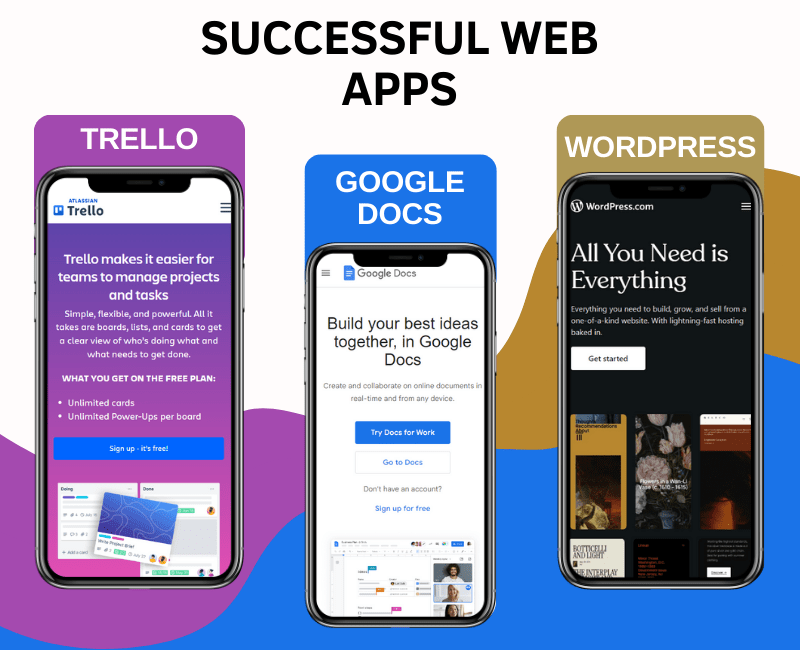
LinkedIn: The professional networking giant leverages web technology to provide users with a seamless experience on various platforms.
Trello: A widely-used project management tool that operates smoothly across web browsers, catering to users worldwide.
Google Docs: This cloud-based collaboration suite demonstrates the power of web apps in enabling real-time document editing and sharing.
WordPress: The popular content management system empowers countless websites, showcasing the potential of web-based platforms for content creation and management.
Choosing between a web app and a native app is not a one-size-fits-all decision. It hinges on your project’s objectives, budget, target audience, and industry. By recognizing scenarios where web apps offer a competitive edge, you can make informed choices that align with your goals. In these scenarios, web apps emerge as versatile, accessible, and cost-effective solutions, enabling you to navigate the dynamic landscape of app development with confidence.
CONCLUSION
In the ever-evolving landscape of app development, the choice between web apps and native apps is not a one-size-fits-all decision. It hinges on a multitude of factors, ranging from your project’s objectives and budget to your target audience and industry. As we’ve explored the strengths of each approach, it’s evident that both have their time and place in the digital realm.
Web apps shine when cost-effectiveness, cross-platform compatibility, rapid deployment, streamlined maintenance, and broad accessibility are paramount. They empower businesses to reach a diverse audience swiftly and economically. In contrast, native apps excel in delivering superior performance, leveraging device features, enhancing user experiences, ensuring offline functionality, and capitalizing on app store visibility.
Ultimately, the choice between web and native apps should be driven by your unique circumstances and objectives. There’s no one “right” answer. So, whether you’re building a project from scratch or considering an update to an existing app, take the time to assess your needs, weigh the advantages of each approach, and make an informed decision. By doing so, you’ll navigate the complex app development landscape with confidence and clarity, ensuring your project’s success in the digital age.
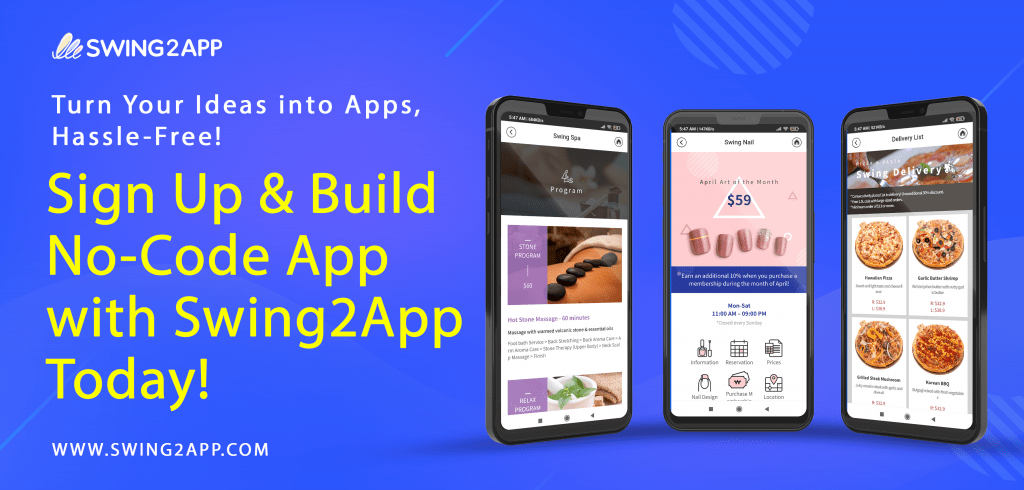
In today’s fast-paced digital landscape, having a mobile app for your business or project is often a necessity. It’s your ticket to reaching a broader audience, boosting engagement, and staying competitive. However, embarking on the app development journey can be a tricky path to navigate, filled with challenges and potential app development risks.
Many entrepreneurs and businesses opt for freelance app developers, hoping to save costs and get the job done quickly. While freelance app developers can certainly offer their expertise, there are inherent app development risks associated with this choice. In this blog, we will delve into these “Freelance App Development risks” and explore alternative paths, such as “In-House App Development” or partnering with “App Development Agencies” for outsourcing, and no-code app developing solutions.
By understanding these app development risks and the alternatives available, you can make an informed decision that ensures your app development journey is not just smooth but also successful. So, let’s dive in and discover the world of app development risks and rewards!
RISKS OF APP DEVELOPMENT WITH FREELANCERS
When you set out on the path of app development, you’ll encounter a crucial decision early on: Who will you entrust with the task of bringing your app idea to life? Each choice—Freelance App Developers, In-House App Development, and App Development Agencies—comes with its own set of advantages and potential app development risks.
In this comprehensive guide, we’ll dissect the risks associated with Freelance App Developers and explore how they measure up against the alternatives.
App Development Risks with Freelancers:
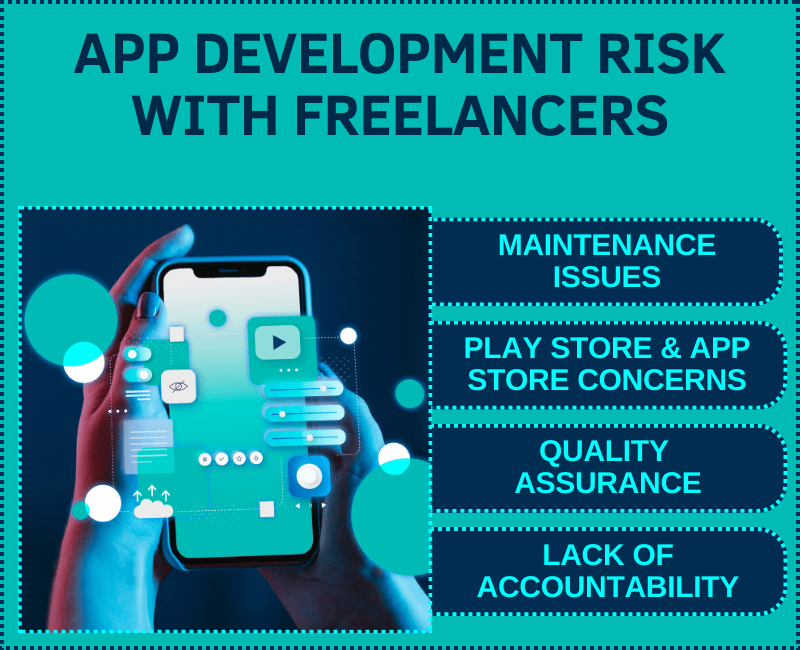
Maintenance Issues:
With freelance app developers, maintaining your app post-launch can become a complex endeavor. Delays, miscommunications, and unexpected expenses can plague your efforts to keep your app up and running smoothly.
Play Store and App Store Policy Compliance:
Freelance app developers may lack familiarity with the guidelines of major app stores. This lack of knowledge can lead to policy violations, potentially resulting in your app’s removal from these platforms.
Quality Assurance Concerns:
Ensuring the highest quality for your app can be challenging for freelance app developers. Inadequate testing and subpar work quality can lead to user dissatisfaction and a tarnished reputation.
Lack of Accountability:
Freelance app developers often work independently, which can lead to accountability issues when urgent matters arise. Having a dedicated team to oversee the project can be challenging.
While freelance app developers may offer cost-effective solutions, it’s essential to weigh these advantages against the potential app development risks. In the subsequent sections, we’ll explore the pros and cons of in-house development and app development agencies to help you make an informed decision and mitigate the risks associated with app development.
EXPLORING ALTERNATIVE APPROACHES TO APP DEVELOPMENT
As you’ve delved into the world of App Development Risks, you’ve recognized that working with Freelance App Developers can be a double-edged sword. While they may offer cost advantages, the associated app development risks, such as maintenance challenges, quality assurance issues, and policy compliance pitfalls, can be significant.
In your pursuit of a safer and more effective route to app development, you’ll encounter alternative approaches—In-House Development, App Development Agencies, and innovative No-Code or Low-Code Platforms. Each of these options brings its unique strengths to the table, aiming to mitigate the app development risks you’ve encountered with freelance app developers.
In-House Development: Taking Control
Establishing an in-house development team empowers you with a heightened level of control over your project. With direct communication channels and a dedicated team at your disposal, you can swiftly address maintenance concerns, tweak features as needed, and ensure seamless ongoing support. While this approach may require a higher upfront investment, the long-term benefits of control and agility can outweigh the initial costs.
Hiring a Reputable Development Agency: Tapping into Expertise
Turning to a well-established App Development Agency offers numerous advantages. These agencies bring a wealth of expertise, experience, and a proven track record to the table. You can leverage their domain-specific knowledge and their knack for handling diverse projects. By entrusting your app to professionals, you mitigate the app development risks associated with freelance app developers and gain access to a wealth of resources that can drive your project to success.
No-Code or Low-Code Platforms: Streamlining Development
In the modern landscape, the emergence of No-Code and Low-Code Platforms has revolutionized the app development process. These platforms allow you to create apps with minimal coding or, in some cases, none at all. By using intuitive interfaces and pre-built components, you can streamline your development journey without relying on r freelance app developers. This approach not only reduces costs but also provides you with greater control and flexibility over your app’s development.
In your quest to mitigate the inherent App Development Risks, exploring these alternative approaches is crucial. Each option offers distinct advantages that can help you steer clear of the challenges posed by freelance app developers. As you assess your project’s specific requirements and objectives, you’ll be better equipped to choose the path that aligns with your vision and ensures the successful development of your app.
SWING2APP VS. FREELANCER: A SAFER PATH TO APP DEVELOPMENT
In the realm of App Development Risks, where the pitfalls of working with Freelance App Developers loom large, an alternative path has emerged—one that promises to simplify the process and mitigate the challenges. Swing2App, a pioneering no-code platform, has gained prominence for offering a compelling solution that stands in stark contrast to the uncertainties of freelance app development.
Swing2App no-code app builder vs freelance app developers: Swing2App A Safer Bet
| Swing2App no-code developer company | Freelance app developers | |
| Commitment and Focus: | 100% commitment and focus on each client by our no-code developing team. | Focus is usually divided into multiple projects |
| Pricing: | One point solution, easily affordable than hiring multiple freelancers | Pricing varies as per project complexity and freelancer expertise |
| Efficiency and deadlines: | We work as per your plan, with no unwanted delays or errors at all | Efficiency totally depends upon workload as he is a one-man army |
| Specialized knowledge: | We have experience as well as knowledge of each step from creation to publishing | Usually specialized in single tasks (only coding, or only UI designing), costly affair |
| Support available 24×7: | 24*7 service provided | No such thing |
| Future maintenance: | Always up to date with late rules and policy changes of Play Store and Appstore | They charge extra for each new update |
| Project Management: | You can check the progress of your app yourself easily | They don’t have much experience in this regard |
| Fixed contract: | Fixed price with long-term and short-term packages | Charge on an hourly basis |
When comparing Swing2App no-code app builder with the complexities and app development risks inherent in hiring freelancers, the advantages become abundantly clear. While freelancers often present challenges in communication, accountability, and quality assurance, Swing2App’s structured approach addresses these concerns effectively.
Communication barriers and project delays, common issues with r freelance app developers, are practically non-existent with Swing2App no-code app builder. The platform’s intuitive interface fosters efficient collaboration and reduces the chances of misunderstandings. Additionally, Swing2App no-code app builder’s consistent support ensures that users receive assistance when needed, eliminating the uncertainty of freelancer availability.
Quality assurance is another critical aspect where Swing2App no-code app builder outshines the freelance app developers. The platform emphasizes rigorous testing and quality control, reducing the likelihood of subpar work. This commitment to excellence helps users avoid the pitfalls of negative user experiences and unfavorable reviews that can plague freelance projects.
In the realm of App Development Agencies, In-House App Development, and other approaches, Swing2App no-code app builder stands as a compelling alternative, offering an array of benefits that mitigate the app development risks associated with r freelance app developers. As you explore your options for app development, Swing2App no-code app builder emerges as a reliable, cost-effective, and user-friendly solution, providing you with a safer path to transform your app ideas into reality.
Benefits of Using Swing2App: Navigating the No-Code Revolution
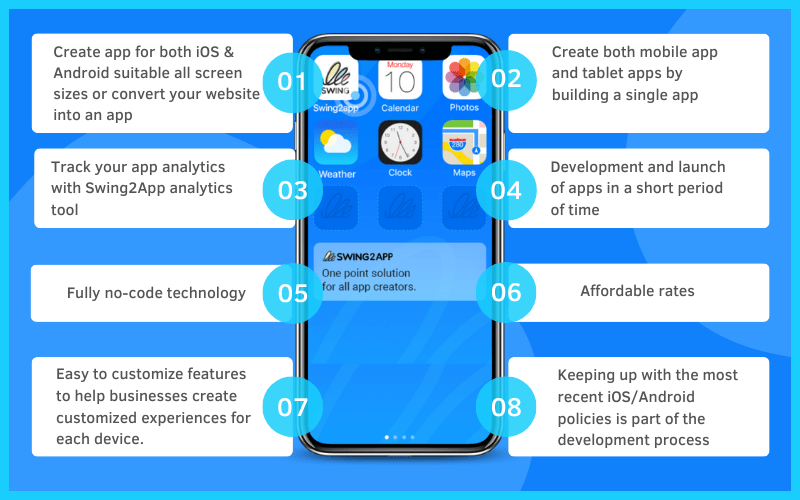
Swing2App no-code app builder shines as a beacon of hope in the landscape of app development uncertainties. It proudly boasts a no-code approach, enabling individuals and businesses to create applications without the need for complex coding skills. The platform’s user-friendly interface and intuitive design empower users to bring their app ideas to life with ease.
One of the standout features of Swing2App no-code app builder is its cost-effectiveness. In contrast to the unpredictability of freelance app development costs, Swing2App no-code app builder offers transparent pricing, eliminating unexpected financial shocks. With this innovative platform, users can embark on their app development journey with confidence, knowing that their budget is well within control.
CONCLUSION
In the world of App Development Risks, the perils of entrusting your project to Freelance App Developers have been unveiled. It’s evident that such a choice can lead to outsourcing app development challenges, from maintenance woes to compliance issues and more. As we navigate the complexities of app creation, it becomes imperative to recognize the vulnerabilities associated with freelance work.
The key takeaway is the need for informed decisions. The realm of app development offers a myriad of paths, from In-House App Development to App Development Agencies and beyond. Rather than taking unnecessary app development risks with freelancers, opting for a development approach that offers reliability and accountability is a better choice.
Embracing alternatives such as in-house teams, renowned agencies, or innovative no-code/low-code platforms like Swing2App no-code app builder can be transformative. It empowers individuals and businesses to embark on their app development journeys with confidence, leaving behind the uncertainties and pitfalls that often accompany freelance app development.
In this ever-evolving landscape, the mantra is clear: make informed choices, embrace reliability, and usher in a new era of app development that prioritizes efficiency, quality, and success.

Discover the booming world of online learning with a fresh perspective! 
Edtech apps like Skillshare, Coursera, and Khan Academy are famous worldwide. Even big players like Google and LinkedIn have joined the edtech trend by launching their own learning and classroom apps. 
If you’re looking to be a part of this educational revolution by building your ed-tech app, you’re in the right place. Swing2App’s no-code app builder is here to empower creators of all backgrounds to craft stunning apps without the fuss of coding. 
Whether you’re envisioning building an edtech app like the existing ones or turning your own idea into an app, Swing2App no-code app builder will help you bring your ideas to life. 
In this post, we’ll unravel the art of building an ed-tech app using Swing2App’s no-code platform. 
So, stick around as we guide you through the exciting journey of creating your own learning and ed-tech app, whether you’re inspired by Skillshare or Coursera, or you have a unique concept ready to shine. 
ONLINE EDUCATION & LEARNING INDUSTRY STATISTICS
The global EdTech industry is a rapidly growing sector that is Revolutionizing the way students learn and get knowledge.
Education is one of the world’s single largest industries, making up more than 6% of GDP. We expect total global expenditure from governments, companies, and consumers together to reach $7.3T by 2025.

Moreover, education is the third most popular category on the Apple App Store, after Games and Business, and the second most popular on Google Play after Gaming Apps.
Did you know that students and learners are embracing educational technology? In fact, 43% of college students in the US have found digital study tools incredibly helpful, according to Statista.
However, here’s the challenge: education often doesn’t get as much funding as other sectors. Innovation, which is vital for progress, requires investment. While governments are grappling with limited budgets for education, schools and institutions are trying to cut costs while also embracing digital transformation.
Here’s where the solution lies: Education needs more private capital to drive the innovation it desperately needs. The key to this lies in Public-Private Partnerships, which can play a pivotal role in fueling growth, fostering innovation, and making education more accessible.
By harnessing the power of Swing2App’s no-code app builder to create innovative ed-tech apps affordably, you can be part of the solution. Your app can contribute to the future of education by providing innovative tools that enhance learning and accessibility.
BENEFITS OF ED TECH APPS
EdTech apps have taken the world of education by storm, and it’s no wonder why. The increasing popularity of EdTech apps can be attributed to the many benefits they offer, such as:
Personalized Learning:
EdTech apps tailor the learning experience to each student’s unique needs. Ed-tech apps understand your strengths and weaknesses and guide you through lessons at your own pace.
Learning on the Go:
You no longer need to be present in a classroom or library to learn something new. With EdTech apps, educational resources are available whenever and wherever you are. Whether you’re on a bus, at home, or in a café, knowledge is at your fingertips.
Interactive Engagement:
Learning becomes exciting with interactive content. From immersive simulations to gamified lessons, EdTech apps make the journey enjoyable. Say goodbye to boring textbooks!
Collaborative Learning:
The EdTech app fosters collaboration among students and teachers. Imagine a virtual classroom where you can discuss, share, and learn from peers and instructors, transcending physical boundaries.
Effortless Progress Tracking:
These apps provide real-time feedback and performance analysis. You can see your strengths, identify areas for improvement, and track your educational journey with ease.
With EdTech apps, learning is no longer confined to the traditional classroom. It’s an exciting adventure filled with opportunities for growth and exploration.
KEY FEATURES OF A SUCCESSFUL ED-TECH APP
For an EdTech app to truly shine, it needs to be a beacon of user-friendly excellence, addressing the unique demands of learners and educators. Here are the features that elevate an Ed-Tech app:
User-Friendly Interface:
Imagine an app that feels like second nature, where every tap and swipe is intuitive. A user-friendly interface is the gateway to seamless learning.
High-Quality, Engaging Content:
Learning should never be a bore, and with an Ed-Tech app, it doesn’t have to be. It’s all about top-notch content that keeps you hooked, and eager to explore every lesson.
Customization and Personalization:
We’re all unique learners, and an Ed-Tech app should honor that. The ability to tailor your learning journey, whether you’re a budding mathematician or a language enthusiast, is invaluable.
Effective Communication and Collaboration:
Learning is often a shared experience. Ed-Tech apps that enable communication and collaboration between students and teachers create a vibrant learning community.
Robust Data Security and Privacy:
Trust is paramount, especially when it comes to educational materials. Users want to know their data is safe. A reliable Ed-Tech app ensures robust data security and privacy measures are in place.
In the world of education, Ed-Tech apps are revolutionizing how we learn and teach. The key to their success lies in these features, shaping the future of education one user-friendly interface, engaging lessons, and personalized experience at a time.
Discover Swing2App no-code app builder, where Ed-Tech app development dreams come true:
No-Code Magic: Build apps effortlessly.
Engaging Content: Curate quality, personalized content.
Seamless Interaction: Foster student-teacher collaboration.
Data Security: Trust our robust privacy measures.
Cost-Efficient: It’s free, no-code, and wallet-friendly.
Long-Term Support: We’re here for your Ed-Tech journey.
Elevate education with Swing2App no-code app builder!
HOW TO BUILD AN ED-TECH WITH SWING2APP?
Ed-tech apps generally sell digital products (PDFs, video courses, coupons) on their apps. So, let’s see how to register digital products on the Swing2App no-code app builder.
Click here to learn how to create an ed-tech app from the beginning using Swing2App no-code app builder.
Swing2App ed-tech app demo:
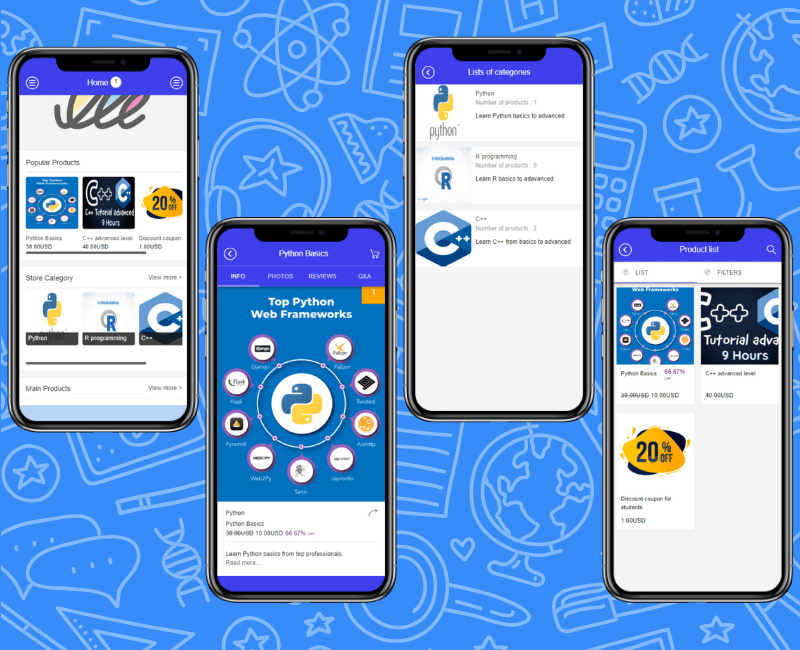
If you want to build an app like this, keep reading!
To create a physical or digital product-selling app you must first register your store details on the Swing store. Swing Store is a shopping mall service provided by the no-code app maker Swing2App.
Swing Store can be registered by selecting a variety of product types – Original Products, reservations products, digital products, etc.
Digital products are the type of product that sells intangible content. Swing2App no-code app builder provides 3 types of digital product registration: Video & file, PDF, and coupons. Let’s learn how to register each type one by one.
However, to register and apply these digital products in your ed-tech app you first need to set up Swing Store. Learn how to apply Swing store menu in your ed-tech app.
Then you must register product categories, only after that you can register products under different product categories. For example, if you create a product category named Python in your ed-tech app, you may create different products under it like Python for beginners, professionals, etc.
Move to Swing Store → Product Management → Product Category Registration Management menu.
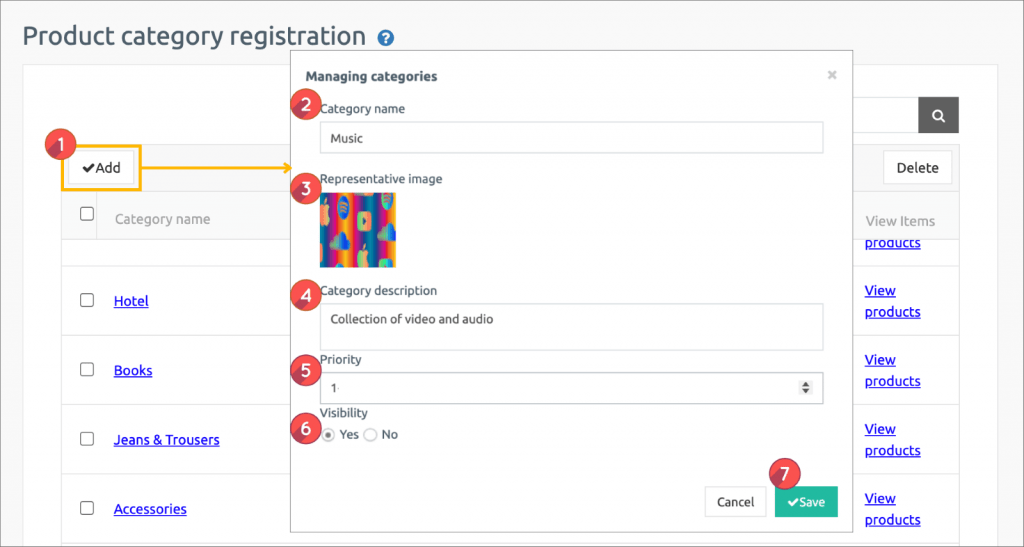
Now, let’s learn digital product registration in your ed-tech app using Swing2App no-code app builder.
1) Select Digital Products [Video and File]
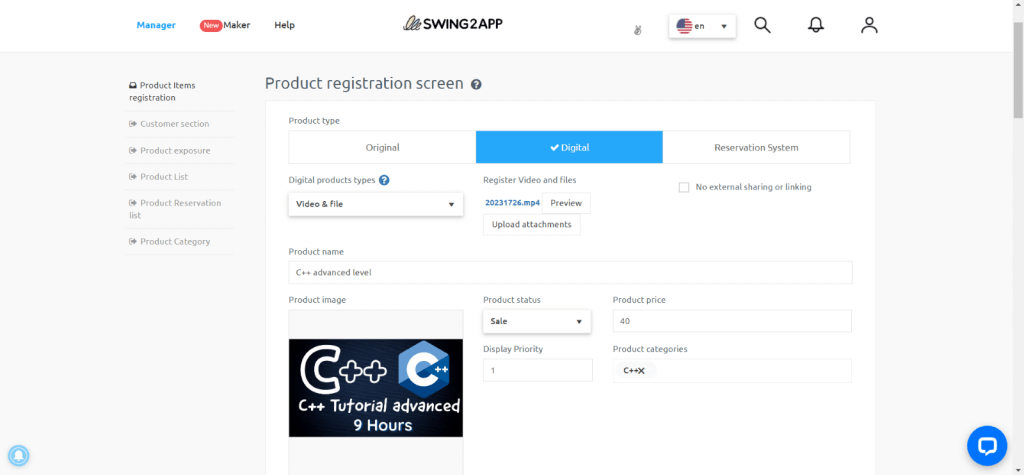
Let’s explore how to register digital products within your Ed-Tech app using the user-friendly Swing2App no-code app builder. This process is designed to make it simple for both educators and learners to access valuable digital resources. Follow these straightforward steps to seamlessly integrate digital products into your educational platform:
1. Select Product Type and Category:
Begin by choosing ‘Digital’ as your product type, ensuring that your app aligns with the needs of your users. Determine the specific category [Video and File] for your digital product, which helps organize and streamline content.
2. Upload Digital Content:
With Swing2App, you can easily upload videos, files, or other digital materials you want to make available within your app. This step allows educators to provide students with convenient access to valuable resources.
3. Define Sharing Preferences:
Decide whether you want to permit external sharing and interlocking of your digital content. If you prefer to limit sharing to within the app, check the ‘Do not share or sync externally’ option.


4. Set Product Details:
Fill up the details: Product Name, Product Image, Registration Status, Product Price, Batch Order and Payment Method.
5. Offer Discounts (Optional):
You have the option to apply discounts to your digital products. If you choose to offer discounts, you can specify the amount and duration.
6. Manage Inventory (Optional):
Determine whether you want to keep track of product inventory. This feature ensures efficient management of product availability.
7. Add Optional Items:
Enhance your digital product with additional optional items that may enhance the learning experience.
8. Provide Product Descriptions:
Brief Description: Craft a concise one-line introduction for your digital product.
Product Description: Offer detailed information, including product images, descriptions, and essential product details.
9. Upload Product Images:
Include multiple images related to your digital product. These images can be reordered as needed to create an engaging visual experience.
10. Customize Order Form:
If your digital product requires specific information from users, customize the order form accordingly.
11. Personalize Ordered Messages (Optional):
Add personalized messages if needed to enhance the user experience.
12. Save and Complete Registration:
Once you’ve filled in all the necessary details, click the ‘Save’ button to complete the registration process.
2) Register digital products –PDF
Please go to Swing Store → Product Management → Product Registration.
1. Product type: Select ‘Digital’.
2. Select Digital Product Type: [change permissions, PDF view, video and file sales, coupons] can be selected. This is the only difference; the rest is the same as above.
Select ‘View PDF’ for the post you need.
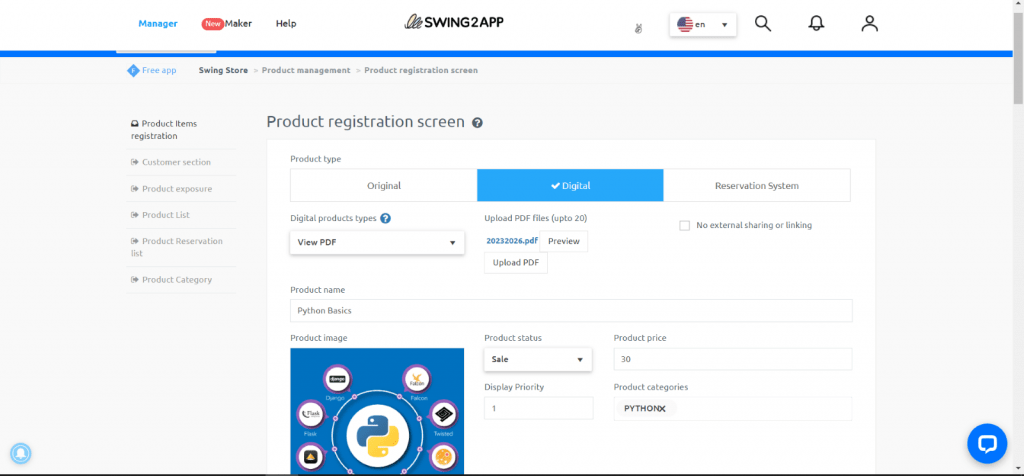
You can sell coupons to users of the swing store digital products by registering the coupon.
You can use the coupon shipping function and swing store payment service provided by Swing2App.
For example, 1-month membership of ed-tech app course, nail shop gel nail coupon, haircut 30% discount coupon, etc.
You can create these coupons, apply them to the Swing Store feature app, and purchase the coupons you want.
Existing swing2app coupon issuing service and + swing store coupons made by combining the way to the actual purchase.
Let’s see how to register your offer in the swing store and apply it to the app.
Register a coupon
Move to Swing2App Manager Page → Services → Coupons menu.
On the Coupons screen, click Add Coupons. A Coupon information window will open and enter the information.
Enter the Coupon name, content, and validity of the coupon either by selecting the date and time or checking Unlimited and the image for the coupon.

Once the category has been created, we’ll register and apply the coupon among digital products.
Go to Swing Store → Product Management → Product Registration screen.
1. Product Type: Select ‘Digital’.
2. Digital Product Type: Select from [Change permissions, PDF view, video and file sales, coupon].
In this manual, you will select and register a ‘coupon’!
3. Select Coupon: Select the coupon you want have created.
4. Coupon quantity: Enter the quantity sold.
The default quantity is 1. (One coupon is issued at the time of payment). If you need to issue multiple coupons at the time of purchase, you can enter the desired number in quantity.
For example, student discount coupons for $10 can be used for the ed-tech apps.
The next steps are similar to the one shown in registering video digital products in your ed-tech app, as shown above.
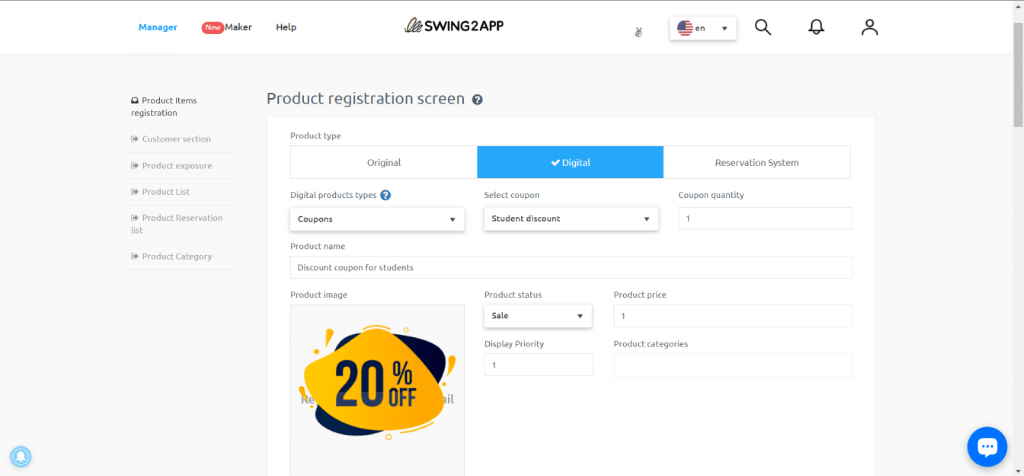
Moreover, with Swing2App no-code app builder you can also restrict users from using/viewing certain features by using the permission group settings.
What is a digital product ‘permission change’?
It is a type of shopping mall that allows users to view the content by buying the rating provided by the app.
For example, VIP customers, premium customers, and top customers are divided into ratings to create products for each level.
Apply content that can be viewed by each grade!
When buying VIP permission -> All bulletin boards can be read
When buying a premium right -> General bulletin boards can be read except VIP board
When buying the right authority -> Only the basic information board can be read
Learn more about the Swing2App no-code app builder permission change option here.
START BUILDING YOUR ED-TECH APP WITH THE SWING2APP NO-CODE APP BUILDER
Unlock the limitless potential of Ed-Tech apps with Swing2App’s revolutionary no-code app builder. Whether you aspire to create a Coursera or Udemy clone or have a unique vision, it’s never been simpler to turn your dream into reality, without the need for coding expertise.
Join the no-code movement today! Sign up for your free Swing2App no-code app builder account and embark on your Ed-Tech app development journey. Our intuitive education app creator streamlines the process, taking mere minutes to craft your vision. Plus, it’s budget-friendly, ensuring your financial peace of mind.
Once your Ed-Tech app is live, the possibilities are endless. Optimize it for app stores, launch marketing campaigns, and spread the word far and wide. Swing2App no-code app builder empowers you to make a significant impact in the world of education, one no-code creation at a time. Don’t wait; start your Ed-Tech revolution today!

The process of turning an app idea into a reality and getting your app published in app stores can often be complex and intimidating, especially for those without coding knowledge or technical expertise. However, with the emergence of no-code app development platforms like Swing2App no-code app maker, the app publishing process has been simplified and made accessible to a wider audience.
In this blog post, we will explore how Swing2App no-code app maker streamlines the journey from idea to app store, enabling individuals and businesses to bring their app concepts to life without the need for extensive coding or development skills. We will delve into the features, steps, and benefits of using Swing2App no-code app maker, providing a comprehensive guide to help you navigate the app publishing process with ease.
THE CHALLENGE OF UNDERSTANDING APP STORE SUBMISSION REQUIREMENTS & PREPARING FOR YOUR APP PUBLISHING PROCESS
App creation completion is just the beginning of the app development process, not the end. The next step is to deliver your app to your users, and for this, you need to publish the app in stores.
For the app publishing service provided by these app stores charges a fee for app uploading and in-app purchases. This is how app stores make their money while helping your app to reach a global audience.
The app publishing process can be challenging, especially if you’re a small business owner. In some cases, businesses must launch apps quickly to take advantage of opportunities. Businesses are increasingly using their own apps to increase sales or to provide customers with an alternative platform for using their tools and services. In fact, 42% of millennial-owned businesses have their own apps.
However, while a mobile app can generate quite a bit of revenue, quickly launching a successful app is made more challenging by its low barrier to entry.
Following are some major challenges faced during the app publishing process:

HIGH COST OF APP PUBLISHING CREATING AN ENTRY BARRIER:
Traditional app developers just create an app for you, to publish your app on the Appstore/ Play Store you need to pay more or hire an app publisher. They charge you for every edit you make in your app to comply with the App Store/ Play Store guidelines.
So, if you don’t create your app compliant with the Appstore/ Play Store guidelines from the very beginning, your app development as well as app publishing costs will increase.
Most small businesses or new entrepreneurs are not well aware of the App Store/ Play Store guidelines and have no option but to pay hundreds of dollars for the app publishing process.
GOING THROUGH LENGTHY COMPLIANCE LAWS OF APPLE/PLAY STORES IS A DIFFICULT TASK:
If you look at Appstore/ Play store guidelines it seems to be endless, but if you miss out even on a single guideline your app will stand rejected, thus halting your app publication process.
For a small business or a new entrepreneur, it is a difficult task to spend long hours reading and understanding each and every App Store/ Play Store guideline.
CHANGING APPLE/ PLAY STORE GUIDELINES & PRIVACY LAWS
As new developments emerge on a regular basis, developers have found it difficult to keep up with the current industry standards.
To ensure a successful launch, programmers must ensure that the software supports the most recent operating systems. When a new version is released, app developers must ensure that the existing app or the app on which they are working supports the latest version. Even after the solution is delivered, app owners must ensure that the app is kept up to date with the latest versions.
Aside from that, most users now prefer to use app development services that offer automated updates, allowing them to access new features, bug fixes, and security patches as soon as they are available.
With large firms like Google, Apple, and Microsoft releasing two to three new versions of their operating systems each year and announcing plans for regular updates beyond that, many small businesses simply cannot compete.
RISK OF APP REJECTION
Now, just going through the App Store/ Play Store guidelines might not be enough. The Apple App Store can be tough on your app and as a small business, you might need a bit of guidance to get the App Store to approve your app. Both the Apple App Store as well as Google Play Store have, in recent times become quite stringent about the apps it approves and this article can help you avoid app rejection and streamline the app publishing process!
UNDERSTANDING SWING2APP: EMPOWERING APP DEVELOPMENT
Swing2App no-code app maker is a leading no-code app development platform that empowers users to create mobile applications without the need for coding or technical expertise. It provides a user-friendly interface and a range of tools and features that simplify the app development process. With Swing2App no-code app maker, individuals and businesses can transform their app ideas into fully functional mobile apps in much less time as well as money.
Swing2App no-code app maker is the best way to launch iOS and Android apps. With just a few clicks, you can get started in seconds. Simply select a template and then you can add features, and menus by adding the required bulletin boards (chat, calendar, Google Maps, and much more).
With Swing2App no-code app maker, you can also add custom functionality. So, if you need something that’s highly customized and can’t find it on our platform, we can also create custom features for you.
As soon as the app is built, we will take care of the app launch on both the Apple & Play store. You just need to click “App Creation Request” when the app creation is completed.
Swing2App no-code app maker simplifies the process of publishing an app quickly and at a fraction of the cost of traditional development. Even better, you don’t have to worry about Apple or the approval process. All apps we prepare are 100% ready for Apple’s App Store and Google Play, and we submit them for you (under your own developer account). In case of a problem, we work directly with Apple or Google to resolve it as well as provide you with 24/7 support.
With Swing2App no-code app maker you won’t have to worry about Appstore rejection!
KEY FEATURES OF SWING2APP NO-CODE APP DEVELOPER KEY FEATURES
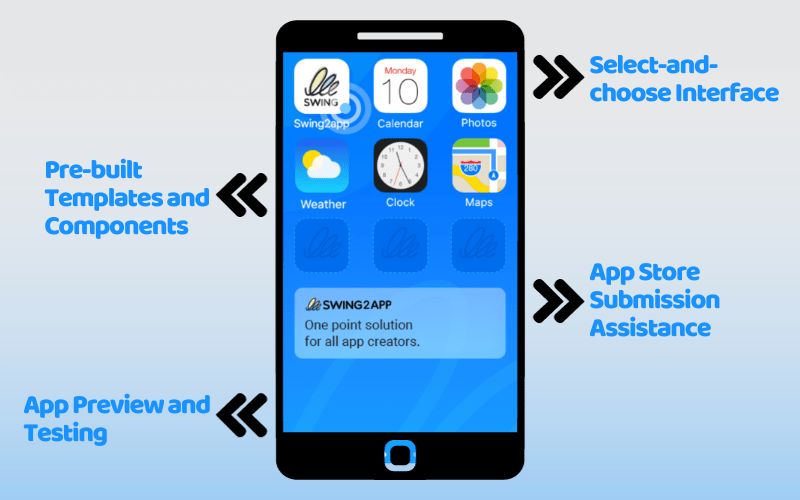
Swing2App no-code app maker offers a wide range of features that make app development as well as app publishing process accessible to everyone. Some key features include:
a. Select-and-choose Interface:
Swing2App no-code app maker’s intuitive select-and-choose interface allows users to easily design and customize their app’s layout, screens, and features. This eliminates the need for complex coding and simplifies the entire design process.
b. Pre-built Templates and Components:
Swing2App provides a rich library of pre-built templates and components that users can leverage to accelerate app development. These templates offer a range of designs and functionalities, allowing users to choose the ones that best align with their app vision.
c. App Preview and Testing:
Swing2App no-code app maker allows users to preview and test their app in real-time, enabling them to experience the app’s functionality before it is published. This feature helps identify any issues or areas for improvement, ensuring a high-quality end product.
d. App Store Submission Assistance:
Swing2App no-code app maker provides guidance and support throughout the app submission process. From generating app icons and screenshots to handling metadata and descriptions, Swing2App simplifies the technical requirements of app store submissions, ensuring a smooth app publishing experience.
STEP-BY-STEP GUIDE: PUBLISHING YOUR APP WITH SWING2APP
Now let’s dive into the step-by-step process of publishing your app using Swing2App:
Step 1: Defining Your App’s Concept and Design
Start by conceptualizing your app idea and defining its purpose, target audience, and desired features.
Utilize Swing2App no-code app maker’s user-friendly interface to design the app’s screens, layout, and navigation flow. Customize the look and feel using the available templates and components.
Step 2: Adding Functionality and Features
Leverage Swing2App’s extensive library of functionalities to add features like push notifications, in-app purchases, social media integration, and more.
Customize these functionalities according to your app’s unique requirements and objectives.
Step 3: Testing and Refining
Use Swing2App no-code app maker app preview and testing features to ensure a seamless user experience and identify any bugs or issues that need addressing.
Conduct thorough testing across different devices to ensure compatibility and responsiveness.
Step 4: App Store Submission
Follow Swing2App no-code app maker guidance and instructions to prepare your app for submission to the app stores.
Generate app icons, and screenshots, and write compelling descriptions using Swing2App’s assistance tools.
Verify that your app meets all the app store guidelines and requirements.
Step 5: App Store Optimization (ASO)
Implement app store optimization strategies to enhance your app’s visibility and discoverability. Optimize your app’s title, keywords, and descriptions based on relevant search terms and trends.
Encourage users to leave positive reviews and ratings, which can boost your app’s ranking and credibility.
Read more about Appstore Optimization to improve your app ranking.
Step 6: Creating App Screenshots and App Preview Videos
Share tips on capturing appealing screenshots and creating engaging app preview videos that effectively showcase your Swing2App no-code app maker’s features and functionalities. Explain the recommended dimensions and guidelines for each app store.
Step 7: Dealing with App Review and Approval
The App Review process is one of the most challenging and stressful parts of publishing an app on the App Store. There is still a great deal of mystery surrounding App Review a decade after its inception.
There are several reasons why your app might get rejected by the App Store or Play Store after the app review process. However, you can avoid your app getting rejected by adhering to the Appstore and Play store guidelines and updating your app timely.
Following all the guidelines is difficult. It can be hard to understand long documents based on App Review because they change frequently. Fortunately, you don’t have to be an expert to do this. Although the specific guidelines evolve over time, understanding the guiding principles behind them can help you sail through App Review.
Further read:
How To Appeal To AppStore Review After AppStore Rejection?
How To Appeal To Google Play Sore Review?
Step 8: Publishing Your Swing2App App: Going Live
The final steps to publish your app include selecting the release date, setting pricing (if applicable), and choosing distribution options (e.g., region-specific availability).
Once your app is approved and live on the app stores, develop a marketing strategy to promote your app to your target audience.
Leverage social media, content marketing, influencer collaborations, and other promotional channels to increase app visibility and downloads.
With Swing2Appp you can publish your app without much hassle by simply buying a Play Store upload ticket and an Appstore upload ticket. Click here to check out How To Apply For App Store Registration & Play Store registration.
Step 9: Post-Release Strategies: Gathering User Feedback and Iterating
For an app to succeed, it needs to be maintained and nurtured. We make sure you’re always in control and running smoothly with Swing2App no-code app maker, where we make sure your business doesn’t stop growing.
After launching your app, it is important to gather user feedback via a survey or App review section of app stores and work with them to update yours as per your customers’ needs.
With Swing2App, we don’t simply publish your app and hope it succeeds. Our goal is to safeguard your app and to ensure that it is future-proof. With our subscription plan, you will have round-the-clock technical support for bugs, software updates, and expert mobile app maintenance. Swing2App no-code app maker’s mobile app maintenance is free and for a lifetime!
Step 10: Promoting Your Swing2App App: Marketing and User Acquisition
Even though higher or exponentially rising app downloads may sound pleasing, they shouldn’t be the primary indicators used to measure a company’s performance.
Of course, more downloads mean more new users, but it’s also important to assess how satisfied current users are.
For example, a new user that downloads your app will increase the total number of downloads, but if they don’t utilize it or even register, it will be a waste of time for businesses. It doesn’t offer anything of real value.
However, even if an app has a small number of downloads but a large active user base, it continues to generate revenue for businesses. Moreover, acquiring new users is way more expensive than retaining the existing ones.
User engagement is a KEY component of app marketing to retain these existing customers. Read more: How To Increase User Loyalty And User Engagement On Your App?
THE BENEFITS OF SWING2APP’S SIMPLIFIED APP PUBLISHING PROCESS
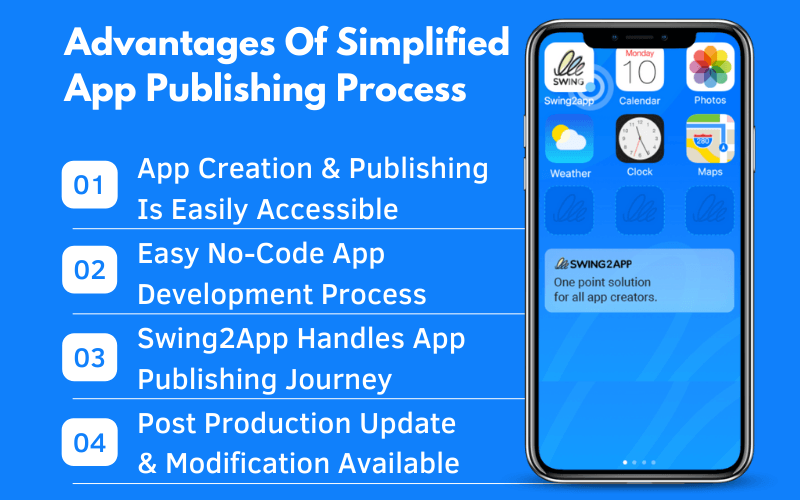
Swing2App’s simplified app publishing process offers several advantages:
a. Time and Cost Savings:
By eliminating the need for complex coding and development, Swing2App significantly reduces the time and costs associated with app creation and publishing. This makes app development more accessible to individuals and businesses with limited resources.
b. User-Friendly Interface:
Swing2App no-code app maker’s intuitive interface enables non-technical users to navigate the app development process with ease. The drag-and-drop functionality and pre-built templates make designing and customizing apps simple and straightforward.
c. Support and Guidance:
Swing2App provides comprehensive support and guidance throughout the app publishing journey. From tutorials and documentation to customer support, users have access to the resources they need to overcome challenges and ensure a successful app launch.
d. Real-time updates:
Swing2App no-code app maker enables users to iterate and improve their apps even after app publishing. With real-time updates and the ability to make changes on the go, users can respond to user feedback and market trends, continuously refining their apps.
Further read:
How To Submit Your App To The App Store
How To Publish An Android App On Google Play Store: A Step-By-Step Guide
CONCLUSION
Swing2App no-code app maker simplifies the app publishing process by providing a user-friendly interface, pre-built templates, and comprehensive support. From concept to app store submission, Swing2App empowers individuals and businesses to bring their app ideas to life without the need for coding expertise.
By streamlining the development process and offering guidance at each step, Swing2App no-code app maker enables users to focus on their app’s unique value proposition and user experience. Whether you’re a non-technical entrepreneur, a small business, or an aspiring app developer, Swing2App no-code app maker can help you turn your app idea into a reality.
Embrace the power of Swing2App no-code app maker and unlock the potential of your app vision with ease and efficiency.

In recent years, with the rise of free app builders, more and more businesses are opting for these free app builders. But you might be thinking is a free app builder the right choice for you? What are the pros and cons of choosing a free app builder for creating an app for your business?
Long answer short—free app builders can be a great option for personal projects, MVP apps, or small business apps. But for complex business apps, a paid app builder might be a better choice.
In this post, we’ll explore the pros and cons of using a free app builder and guide you on how to choose the right app builder for your needs. By the end of this post, you will be able to decide whether a free app builder is the right choice for your app development project.
THE PROS OF USING A FREE APP BUILDER
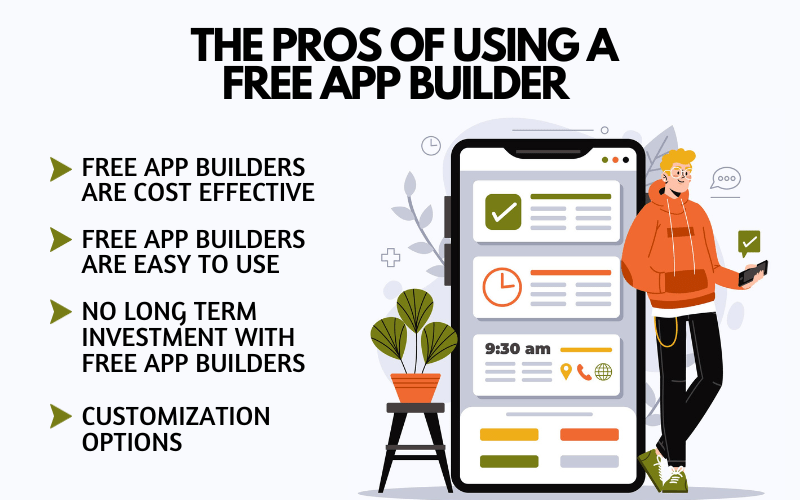
The major advantages of using a free app builder over paid app builders are:
Free app builders are Cost Effective
One of the biggest and most obvious advantages of using a free app builder is its cost-effectiveness. There is absolutely no need to pay for the app development process when you use a free app builder.
Especially for small businesses, start-ups, and individual entrepreneurs who may not have the budget for a paid app development service these free app builders are a boon. With a free app builder, anyone can build an app without investing a lot of money.
However, it’s important to understand that while using a free app builder may save you initial investment on the app development costs, it may not be entirely free. Most of the free app builders offer limited features for free and charge for additional features and functionality.
A clear understanding of the price policy of the app builder you choose is a must so that it doesn’t impact your budget for other things like marketing. Moreover, a contingency amount must be kept aside for additional costs that may come up in the future.
You must also consider the long-term costs associated with the free app builder like app launch and maintenance. While choosing a free app builder may seem cost-effective in the short term, however, you might end up spending much more to scale your app or to add a specific feature to your app.
Hence, you should be farsighted and analyze the short-term benefits over long-term costs before investing in a free app builder.
Free app builders are Easy to Use
Free app builders are designed to be user-friendly and do not require coding knowledge—like a DIY app maker. The no-code free app builders are extremely helpful for everyone, especially for those who have little to zero coding skills but still want to build an app.
Free app builders enable you to build an app easily by providing drag-and-drop features or pre-designed templates to build an app easily without the need for any coding knowledge.
The no-code functionality can save a lot of time and effort for both coders as well as non-technical people, thus allowing them to focus on the design, functionality, and other aspects of the app building.
Moreover, free app builders often provide detailed tutorials and resources that can help users navigate the no-code platform and build the app they want. This makes no-code app builders even easier to use to build an app, even if you’re not an expert.
One example of a free app builder that provides an easy app-building platform is Swing2App no-code app maker. Swing2App’s no-code app maker platform is user-friendly, making it accessible to users of all skill levels.
Apart from being a simple and easy-to-use app-building platform, Swing2App no-code app maker also has a support team that’s available to assist users at all times. Swing2App no-code app maker’s ease and simplicity, pre-built templates, features, and customization options, make it a great option for those looking to create a functional and professional-looking app.
Customization Options
Most app builders allow users to build an app that is easily editable and customizable to their specific needs. For this free app builders provide options like different color schemes, layouts, and design elements, as well as custom functionality and features.
The customization feature allows users to build an app that really represents their business and stands out in the app market.
For example, Swing2App no-code app maker provides a variety of industry-specific pre-built templates or creates their own layout using the visual select-and-choose interface. Additionally, Swing2App no-code app maker allows users to add custom functionality and features like maps, calendars, payment options, etc. to their app with a single click.
All you have to do is choose from pre-built functions from the Swing2App no-code app maker platform and link it with your app menu option. Other free app builders may also provide customization, however, the degree and quality vary.
Moreover, some free app builders may limited free functions, so it’s important to do your research and find the app builder that best suits your needs. However, as long as you’re willing to put in some time and effort, it’s possible to create a professional-looking and fully-featured app with a free app builder.
No long-term investment with free app builders
Utilizing a free app builder has the important bonus of letting you build an app without making any long-term commitments. You can design an app for free and test it out before deciding whether to put more money into it. This can be particularly helpful for companies who are just getting started or are unsure if developing an app is the correct step for them.
You can test out various layouts, features, and capabilities without spending any money. Before investing in a more expensive app development process, this might be an excellent strategy for developing a sense of what works and what doesn’t. This freedom enables you to decide for yourself where your app is going and whether it needs allocating more resources to it.
An excellent option to prototype your app idea or launch a minimum viable product is to use a free app builder. To test your app and get user input, you can construct a minimal version and test it out with a small group of people. This might assist you in finding any problems or potential improvement areas.
Overall, the fact that free app builders come with no obligations gives people and organizations a wonderful chance to test the waters and determine whether an app is an appropriate match for them before making any significant decisions.
THE CONS OF USING A FREE APP BUILDER
We know that there are many advantages to using a free app builder, but there are also some drawbacks you must consider:
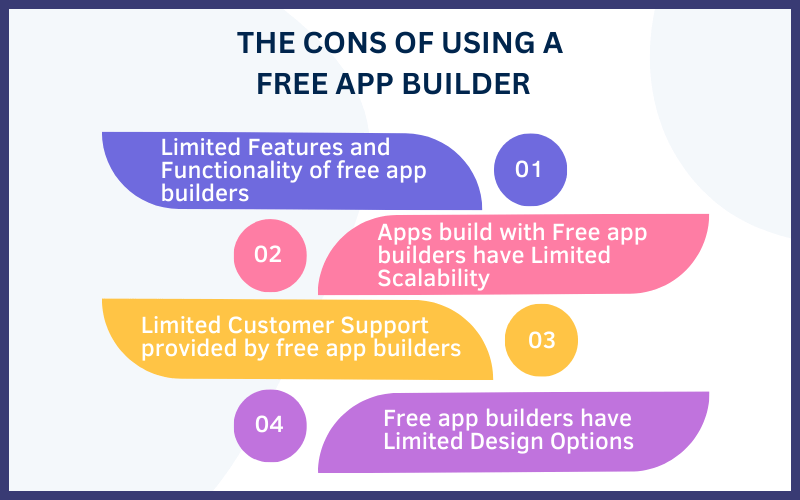
Limited Features and Functionality of Free App Builders
Free app builders typically offer a restricted number of features and functions than paid app builders. The overall functionality of the app may be eventually limited by this.
For instance, free app builders might not include cutting-edge features like push notification support, social media links, or e-commerce capabilities.
These features can be important for businesses looking to build a fully-featured and functional app. Free app builders might not provide the same level of resources and assistance as paid app builders, which can make it more challenging to resolve any potential problems.
Another issue with free app builders is that they often come with limitations on the number of users or downloads that can be supported. This can be problematic for businesses looking to create an app that will be used by a large number of users. You may also encounter limitations on the amount of data that can be stored or the number of pages that can be created.
So while free app builders can be a great option for small-scale projects or personal use, they may not be the best choice for businesses looking to create a fully-featured and functional app. The limited features and functionality of free app builders can be a significant drawback, and it’s important to consider this before deciding to use a free app builder for your app development needs.
Apps built with Free app builders have Limited Scalability
While free app builders may be the best option for small businesses, MVPs, or personal use, they may not be able to handle the demands of a growing business or provide a scalable app.
Getting huge downloads with an app created using a free app builder is far from reality, as they may not be competent enough. This becomes a huge hurdle for businesses looking to expand and scale their business app by increasing user base, downloads, or data storage capacity.
For scaling your app, you’ll need to upgrade to a premium paid plan of the app builder for more user base or data storage.
Free app builders usually are unable to handle too much user traffic and data, which leads to poor app performance and user dissatisfaction.
Moreover, a growing business may require new features and functionalities to be added that are not available on a free app builder. This may require the business to invest in a more expensive app development process if they do not choose the right app builder at the beginning.
Limited Customer Support provided by free app builders
A few free app builders may offer a basic level of customer support which is often more limited compared to paid app builders.
However, the customer support quality offered by different free app builders varies a lot. So before deciding to use a specific app builder, it’s important to contact various free app builder support teams to check if the solutions are satisfactory or not.
Some free app builders, for example, may simply provide minimal assistance to customers, through a FAQ website or a community forum. These tools can be useful, but they might not be able to offer the same level of assistance as a specialized customer service team.
For example, if you upgrade your service with a Swing2App no-code app maker, you can connect with a Swing2App developer team to discuss each and every part of the app development process. This type of service is hard to get with a free app builder.
For businesses looking to develop a fully functional app, customer support is essential to guide them through the customizations and app integrations. Without this, it might be more challenging to customize the app in order to meet the needs of a growing business.
This can be a major disadvantage, particularly for companies wanting to develop an app for actual consumers.
Free app builders have Limited Design Options
To build an app, the app design, theme, color, etc. are just as important as the functionality. However, a free app builder provides only a limited number of design options.
Moreover, the free templates and designs provided are comparatively more basic than those provided by paid app builders. Hence, it can be more challenging to build an app that is professional, appeals to customers, and stands out in the market.
Additionally, the app design elements provided by free app builders may not be as easily editable as those offered by paid app builders. For example, some free app builders may only provide limited fonts, themes, or color schemes. This can make it difficult to build an app that actually represents your brand or style.
Also, many free app builders don’t offer advanced features like interactive navigation, app animations, and other design elements that can make your app more engaging and appealing. This can be a huge disadvantage, especially for businesses looking to create an app that appeals to customers and stands out.
CHOOSING THE RIGHT FREE APP BUILDER
Choosing the right free app builder is important to build a successful app. With the rising app demand many free app builders are coming into the market, each with its own unique set of features as well as limitations. It can be difficult to choose the right app builder for your business, especially if you are new to app building.
With Swing2App no-code app maker, you can create an app that looks professional and functions seamlessly. The best part is that you can try Swing2App no-code app maker for free, and test its features.
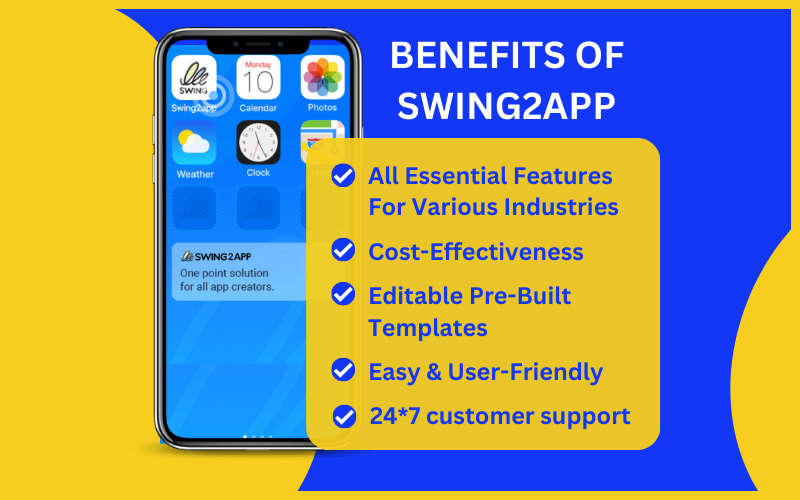
Swing2App no-code app maker is a powerful and user-friendly app builder that offers a wide range of functionalities and features as well as customizations.
With Swing2App no-code app maker, you can build an app that is professional and functions efficiently. The best part is that you can try Swing2App no-code app maker for free, test its features, and see if it’s the right fit for your app.
One of the major benefits of Swing2App no-code app maker is its cost-effectiveness—you can create an app without investing huge money.
Swing2App no-code app maker has affordable paid app plans suitable for all budgets. Even though you can use the app builder for free, you have to pay to publish your app in the app stores.
Another advantage of Swing2App no-code app maker is its ease of use. The no-code app builder is extremely user-friendly, making it easy for anyone to build an app, without any coding. Moreover, Swing2App no-code app maker also offers excellent customer support, to guide you through the entire app development process.
CONCLUSION
For many app developers, using a free app builder might be an excellent choice, but it’s crucial to evaluate the pros and cons before making a choice.
Using a free app builder can be very advantageous because it allows developers to create apps without spending a fortune. In addition, the majority of free app builders are user-friendly, making it simple for anyone, regardless of technical proficiency, to create an app.
However, there are limitations associated with using a free app builder. Some of the drawbacks that app developers should take into account are limited functionality, limited scalability, and limited design possibilities.
App developers must ultimately decide whether a free app builder is the best option for their app. App developers may be confident they’re choosing the finest option for their app by weighing the advantages and disadvantages and spending the time to choose the best app builder.

Modern app development technologies like no-code/low-code, generative AI (Artificial Intelligence), machine learning, and others are transforming the landscape of app development. The drawbacks of legacy app development are somewhat overcome by modern app development solutions, so now is the right time to shift from traditional legacy app development and switch to modern app development solutions.
Businesses often invest heavily to buy or develop custom applications to facilitate essential business operations. Unfortunately, for any future app updates, businesses are heavily dependent upon legacy app developers, that is traditional coders. A company must pay more for every change and even take a long time to implement, which creates a disconnect with customers.
Modern app development solutions offer more comprehensive benefits such as platform flexibility, application scalability, agility, security, and cross-platform compatibility. This article delves into the benefits of shifting from Legacy Application to Modernization of app development process, related challenges, and how to create apps with modern app development solutions.
WHAT IS LEGACY APP DEVELOPMENT?
Legacy systems in life and P&C are built on outdated architectures with high maintenance costs, inherent inflexibility, redundant features, lack of connectivity, and low efficiency. Complex application and process logic is often hard-coded and undocumented.
Gartner
A legacy app system is a traditional piece of software, technology, or approach/language that a company still employs even if it has been replaced by more recent technology. Since the original vendors or producers no longer support them, maintaining and upgrading these systems can be expensive or complex. Integrating legacy systems with other systems is difficult because they are incompatible with current hardware or software platforms.
When applications start to present these typical problems, they become legacy app systems:
- Difficult and costly to maintain or update, and time-consuming too
- App performance issues, instability, or not being able to scale the app.
- The legacy app system may not interact with newer hardware
- The system is not agile to the changing customer needs
- No security updates and compliance risks
These are a few reasons why businesses should switch from traditional/ legacy app development to modern app development solutions.

A legacy system may be old-fashioned or complex, but it is not always outdated. Legacy systems can function at acceptable output levels and are crucial to the everyday operations of many businesses. They use the best application modernization technologies to maintain the functionality of their legacy software.
The need for digital transformation is fueling the rising demand for application modernization tools, which is expected to push the market value of this sector to $36.86 billion by 2027.
Businesses should think about modernizing legacy systems with modern programming languages and protocols after they reach a particular level of competence. In order to support an IT organization’s efforts in digital modernization, it is first crucial to comprehend the significance of legacy application modernization methodologies.
WHAT IS THE MODERNIZATION OF LEGACY APPLICATIONS?
What is legacy system modernization, one might wonder. The legacy app modernization procedure of taking a legacy system and updating it to integrate contemporary platform infrastructure, architecture, and/or features.
Depending on the status of the legacy system, the issues facing the organization, and the business objectives guiding the app modernization (and digital transformation), the road of application modernization can take many different turns. There are numerous modernization techniques to move, update, and optimize legacy systems to more contemporary architecture, therefore application modernization goes beyond simple replacement.
Using Legacy Application Modernization, existing software can be repurposed to run on modern devices and applications. Rebuilding these applications requires rewriting their source code, enhancing their functionality, or plugging them into a modern platform.
LEGACY APP DEVELOPMENT VS. MODERN APP DEVELOPMENT SYSTEMS
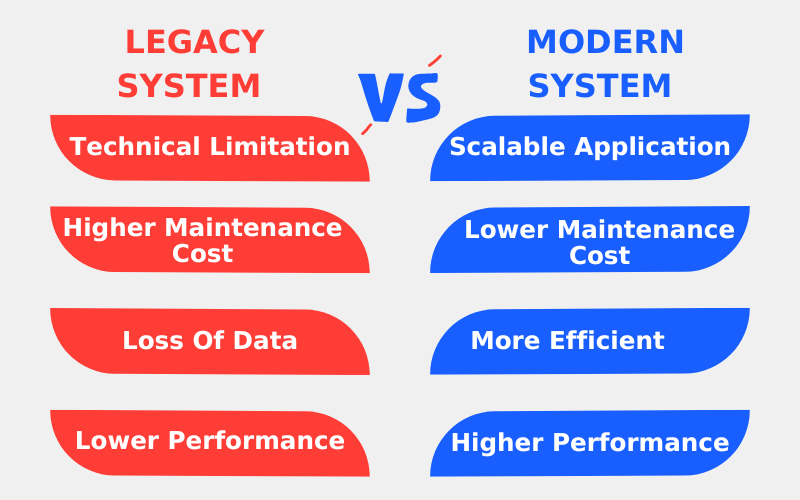
KEY REASONS TO MODERNIZE LEGACY APPLICATIONS
Keeping up with changing consumer needs is easier with legacy app modernization, which allows organizations to adopt modern technology and stay competitive. Modernizing apps has several key benefits for organizations:
Benefits of modernizing legacy apps for business aspect:
- Maintaining old legacy apps is costly, however, modernizing legacy apps reduces operational costs.
- Modernizing legacy apps provides a competitive advantage, enhanced app performance, scalability, and agility.
- Modernized Legacy Applications make apps efficient and flexible (different platforms)
- Improved customer satisfaction as legacy app modernization boosts performance and app UX (user experience).
Benefits of modernizing legacy apps for technical aspects:
- Simple API (Application Programming Interface) integration with other programs and third-party tools.
- Applications are protected from changing security risks by modernization.
- improved application performance with lowered security concerns and trustworthy procedures.
- enables the adoption of effective operating frameworks and methodologies, including DevOps.
HOW TO SHIFT A LEGACY APP TO THE CLOUD: LEGACY APP MODERNIZATION
While the best strategy for shifting from legacy apps to the cloud varies as per the organization, there are some common steps that can ensure a successful app modernization.
1. Assess the Existing Tech Stack
Organizations must carefully evaluate the effectiveness of the current system for business processes. To do this, a thorough assessment of linked applications and infrastructure is needed, which will eventually serve as the foundation for the migration strategy and determine whether the system is worth upgrading. Additionally, teams can streamline migration costs and efforts by using audits and assessments to determine which infrastructure or software no longer serves a purpose for the company.
Some important steps to include:
- A review of the high-level architecture and parts of the application to find roadblocks and choose the best migration plan.
- A thorough audit of the source code is performed to find bugs, vulnerabilities, and platform compatibility.
- To guarantee that user experiences are effortlessly transferred over and stay identical, UI/UX experts evaluate user interfaces, related procedures, and processes.
2. Choosing the app Modernization Approach
Deciding the right app modernization approach is the basic step before continuing the actual journey. As per the business case, one of the two approaches might be followed:
Disruptive:
In most cases, this legacy app modernization approach relates to a lift-and-shift method in which the entire application is re-hosted to the cloud in a single milestone. With this method, all the organization’s workloads may be quickly deployed to the cloud as the traditional platform is retired. The disruptive strategy has a quicker implementation time and is seen as ideal for businesses with less sophisticated, smaller workloads.
Phased:
The term “phased strategy” refers to a method in which the application workloads are moved to the cloud in a series of manageable milestones over time. This legacy app modernization strategy is seen to be appropriate for organizations with numerous business divisions and for large migration initiatives where training the workforce takes time. A phased approach additionally provides advantages like simpler change management and a decreased risk of failed migration.
3. Creating the Right Team
Organizations must prepare to onboard the right team of specialists who will guarantee flawless transitions from legacy apps to the cloud because operating an application on a cloud-native ecosystem demands specialized capabilities. This can be accomplished by retraining the company’s current employees, acquiring new personnel, or outsourcing the transition management to a third party. These professionals are in charge of identifying the workload components that need to be shifted as well as any potential difficulties.
Using the Agile model as part of the migration is a well-known strategy to guarantee a thorough and highly collaborative transformation. Organizations may effectively meet changing consumer expectations and achieve operational excellence with the correct Agile team structure.
4. Financial Planning
The costs of moving to the cloud must be taken into consideration by organizations. This usually involves an initial one-time payment for the change and recurring costs while using the cloud. The migration program should identify financial predictions for the pre-migration, migration, and post-migration stages when budgeting for a cloud-based legacy app modernization. By properly allocating resources for configuration and deployment, budgeting effectively enables organizations to reap the full benefits of cloud migration.
5. Choosing the Cloud Service
When shifting from legacy apps to cloud-based modern app development techniques, choose the right kind of cloud service for your business needs. You may choose any one out of the following three models:
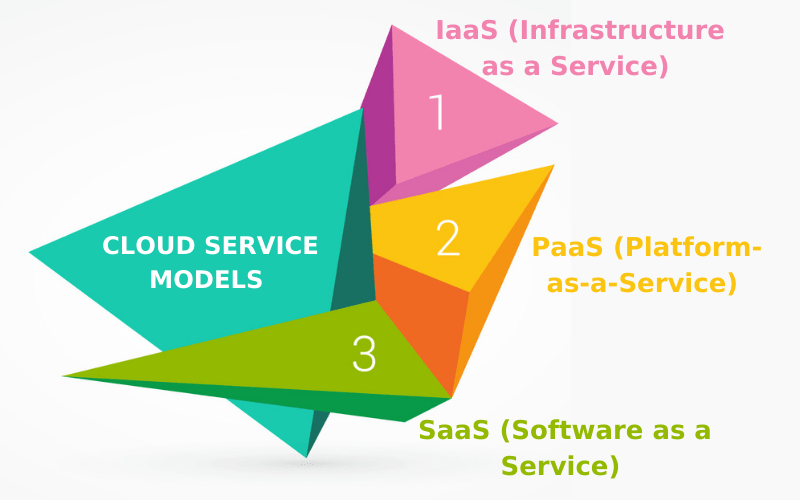
IaaS (Infrastructure as a Service)
Infrastructure-as-a-Service (IaaS) enables organizations to get infrastructure resources on demand such as networks, storage, processors, and servers. Organizations only must pay for the infrastructure they actually use for their workloads, which can be increased later to meet the changes in resource demand.
Some popular IaaS include Microsoft’s Azure, Amazon’s Web Services (AWS), and Google Cloud Platform (GCP).
PaaS (Platform-as-a-Service)
Platform-as-a-Service enables businesses to concentrate on building code and automating deployment pipelines by letting cloud providers manage the hardware and operating systems. Efficiency is increased since complicated capacity planning, resource acquisition, and software maintenance are taken care of by PaaS.
Some popular PaaS include Windows Azure, AWS Elastic Beanstalk, and the Google App Engine.
SaaS (Software as a Service)
In Software-as-a-Service, the software providers develop apps to be offered over the web. With SaaS models, organizations only need to plan, develop and maintain the app for end-use, rather than maintaining the underlying infrastructure or related platform.
Some popular SaaS applications include Microsoft Dropbox, Google Workspace, Salesforce, and SAP Concur.
HOW TO USE SWING2APP TO SHIFT FROM LEGACY APP DEVELOPMENT TO MODERN APP DEVELOPMENT
Swing2App comes under SaaS service, where we provide you the software in the form of a no-code app development website. Here you just must plan the structure of your app and everything else is provided by the Swing2App no-code app builder.
Your entire application gets coded in the back end while you are visually creating the app using our website.
Rather than shifting later from legacy apps to the modernization of app development, choose Swing2App no-code app builder from the start. Here you can create no-code apps using the modern app development technique of no-code solution.
Most companies’ IT departments are overburdened. They have a massive backlog, and new requests for solutions never seem to stop coming in. That is why it is critical to empower citizen developers. They claim to have a solution for both budget and staffing issues, and all they need is a good no-code platform.
Swing2App’s citizen development platform is a simple work platform that will help you become a citizen developer quickly. It does not require extensive restructuring to use and contains a plethora of excellent tools that are simple to grasp. Sign up for a free trial today to get started building apps on a budget.
By using Swing2App, you have the ease and joy of creating an app on your own while maintaining your creativity.
Benefits of Using Swing2App:
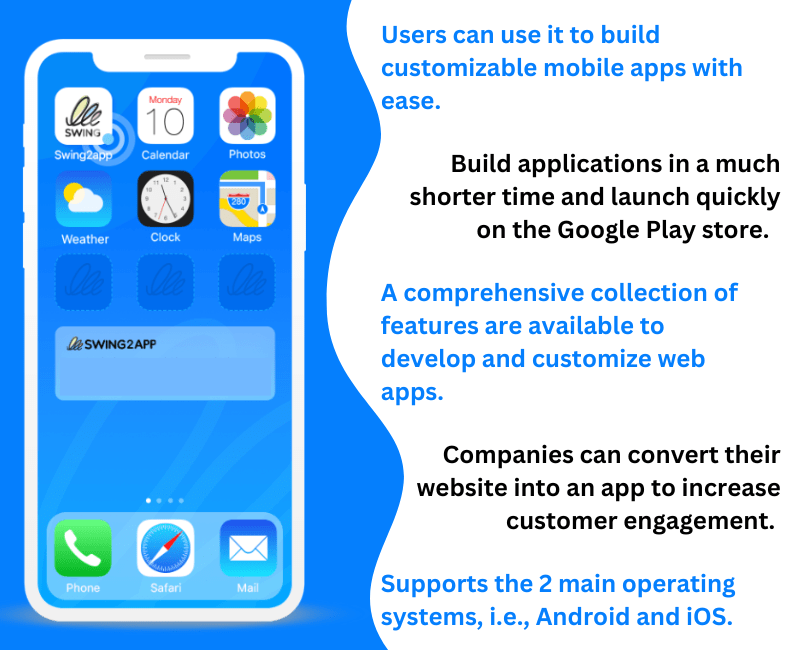
Come up with a great idea and transform it into a brilliant app without any coding, only with Swing2App no-code app builder!
CONCLUSION
Organizations are increasingly adopting the cloud to modernize legacy applications since cloud computing offers rapid acceleration of organizational growth. According to a recent Gartner survey, which continues the current trend, roughly 70% of businesses that already use cloud services intend to raise their cloud investment in the future.
Traditionally, legacy programs that rely on slow, monolithic frameworks are run on-premises. As a result, legacy applications are unable to meet the new devices’ demands for agility and performance. Organizations must be aware of the obstacles and the best approach as they migrate to the cloud to enable digital transformation and modernize applications. However, the best migration plan is determined by the application’s type, the budget, and the demands of the company.
]]>AI has taken all over the world. ChatGPT has transformed everything around you. Sticking to traditional ways is not a wise decision; your competitors are using ChatGPT and other generative AI, so you need to as well.
Industry-specific generative AI tools like marketing AI, and graphic AI have received substantial investment, and it is strongly believed to transform marketing, designing, and other aspects as well As per Sam Altman, the CEO of the ChatGPT, “generative text is something we all need to adapt to.”
The goal of this article is to have you start using AI and explore how app marketers can improve key performance indicators (KPIs) for apps with ChatGPT prompts.
Read on to know the various use case prompts and start leveraging ChatGPT generative AI to improve your company right now!
Note: I’m assuming you’re familiar with what ChatGPT is and have a user account. If this is not the case, then click here.
WHAT KEY PERFORMANCE INDICATORS (KPIs) SHOULD YOU TRACK FOR APPS?
Everyone knows they should be tracking KPIs, but most businesses don’t have good KPIs defined. ChatGPT can help!
You may use the following ChatGPT prompts to identify the KPIs for your business.
[What KPIs should I track for my app?]

[What SMART (Specific, Measurable, Achievable, Relevant, and Time-bound) key performance indicators (KPIs) should I track for my application.]

[Tell me best practices for tracking, reviewing, and updating KPIs for my mobile app ]

It is essential to define and analyze the correct key performance indicators (KPIs) that indicate growth or potential challenges for your app’s journey to success. We found the following four major key performance indicators (KPIs) for app development success:
- Acquisition metrics
- Re-engagement metrics
- Support metrics
- App growth
Let’s delve deeper to find how to use ChatGPT prompts to improve KPIs for apps.
HOW TO USE CHATGPT PROMPTS TO IMPROVE ACQUISITION METRICS FOR APPS:
For any app looking to grow its user base and generate more revenue, improving acquisition metrics is crucial. There are different ways marketers can improve acquisition metrics, but let’s see how ChatGPT can help.
User acquisition encompasses various key performance indicators (KPIs) that may be monitored and manipulated to enhance your overall app performance. Downloads, return on ad spend (ROAS) & Customer acquisition cost (CAC), Audience targeting, Ad copy and creative optimization, A/B testing, Customer lifetime value (cLTV), Customer feedback analysis many other key performance indicators (KPIs) fall under the Acquisition metrics.
However, here we shall focus on only a single aspect, that is using ChatGPT prompts to improve app downloads and thus improve the acquisition metrics.
How to use ChatGPT prompts to improve app downloads :
User acquisition simply means how many downloads your app has across the different app stores or marketplace (App Store, Play Store, etc.). Here’s how ChatGPT can help improve downloads for subscription apps:
Appstore Optimization (ASO):
Get recommendations for improving your app’s title, description, keywords, and screenshots through ChatGPT to optimize your app’s store listings. By optimizing your app store listings, you can increase the visibility of your app and attract more people to download your app.
App marketing strategy:
ChatGPT can also help you in identifying the major marketing channels for a specific app audience. Moreover, the ChatGPT generative AI tool can even suggest the prominent social media influencers who are working in line with your target audience and may be interested in promoting your app to their followers.
Behavior analysis:
Through ChatGPT, you can identify patterns and trends in user behavior to enhance user experience. Through the analysis of user behavior and needs, app marketers can optimize their app’s store listing, which leads to increased downloads.
For example, you may use the following ChatGPT prompt to improve the app acquisition metric:
[I have a subscription app that focuses on diet and nutrition, for which I want to identify marketing channels where I can target audience. Provide me the list of the top 10 marketing channels where I can reach my target audience.]

HOW TO USE CHATGPT PROMPTS TO IMPROVE RE-ENGAGEMENT METRICS FOR APPS:
User re-engagement, also called retention metrics, shows how engaged users are with the app. The retention metrics should be maintained at a high level and the reasons for churn should be identified. Knowing that helps app marketers react in time and keep company revenue stable. The ChatGPT tool can be a valuable tool for generating ideas on how to retain users.
Retention metrics also include a plethora of key performance indicators (KPIs) like Subscription retention, churn rate, User journey, and content personalization, among the other important KPIs.
Here we shall discuss Subscription retention extensively and find out what kind of ChatGPT prompts can be used to improve the app Subscription retention rate.
How to use ChatGPT prompts to improve app subscription retention :
Retaining customers is critical to growing a successful subscription business, thus it’s an important indicator to monitor. Ideally, the churn rate for any particular demographic should decrease with time. In simple terms, the longer a client is a subscriber, the more likely they are to remain a subscriber. However, in order to convert your app users into loyal customers, you must use strategic techniques, which ChatGPT can help you with:
Incentives and rewards:
You can create and implement incentives and promotional programs to persuade users to buy or renew their subscriptions with the support of ChatGPT. You can motivate users to keep using your app by rewarding them for certain actions, like renewing their subscription early or upgrading to a premium subscription.
User feedback:
ChatGPT can be useful for collecting, comparing, and analyzing user input to identify problems and areas in which your application can be improved. You can boost user satisfaction and retention by paying attention to subscriber feedback and acting on it.
Churn prediction:
When a subscriber is about to leave, ChatGPT can foresee it and offer customized interventions to keep them from leaving. You can spot users who are at risk of churning and respond with personalized promotions or engagement strategies to retain them by analyzing user behavior and engagement data.
For example, you may use the following ChatGPT prompt to increase the app retention rate:
[ I am an app owner, and many paid users are not engaging well with my app. I want to know some ideas that will help me increase retention rate of my app that help users in maintaining their health and nutrition.]

HOW TO USE CHATGPT PROMPTS TO IMPROVE SUPPORT METRICS OF APPS:
The support team of your app needs to be well-prepared in advance to successfully answer and resolve any queries that users may have regarding your app. You can avoid losing consumers due to a lack of app support by tracking the quality of your customer support and customer experience.
App support and Feedback analysis form the backbone of the key performance indicators (KPIs) under the support metrics. However, it is not limited to just these two key performance indicators (KPIs). Social listening, I.e., what people say about your app on various social media platforms, Net Promoter Score (NPS) survey (app recommendations), Sentiment analysis etc., also form a crucial part of the support metrics.
Let’s look at how ChatGPT may help maintain these support metrics at the highest level.
How to use ChatGPT prompts to successfully solve support queries:
Monitoring the volume of support cases opened over time and the proportion of those that are successfully addressed is a helpful key performance indicator. Customer success, however, is mostly focused on responding to user demands. As we are all aware, finding the appropriate words to address some sensitive requests is not always easy. ChatGPT can help you in this situation with personalized messages as well as other things.
Automated responses:
With ChatGPT’s helping hands, you can set up automatic solutions to frequent support issues in a matter of minutes. You may speed up response times and increase the success rate of support cases by automating responses for common problems.
Personalized support:
You may help users by providing them with customized support with the help of ChatGPT. You can improve the success rate of support cases, boost user satisfaction, and build brand loyalty by personalizing support responses to each user’s unique needs and preferences.
Sentiment analysis:
You can analyze user sentiment in support cases with ChatGPT to find areas where the support process needs to be improved. By analyzing user sentiment, you can pinpoint problems and areas for improvement in the support process, which could result in enhanced success rates in the future.
For example, you may use the following ChatGPT prompt to improve app support metrics by creating a successfully solved support case:
[I am an app support specialist and I want to who resolve a user’s request. The user request: How to switch from freemium to premium model, the answer to which is: the user has to buy a premium annual subscription shown in the “My package” category, here they can view the various premium paid packages like $20/year for nutrition guide only an $400 for nutrition guide + exercise coach too. Moreover, users can switch to freemium model within 30 days of purchase if not satisfied, no questions will be asked. Tell me how to answer the user to successfully resolve the request of the user.]

Furthermore, you can create a compilation of all the user queries in this way and save them for future use. This will save a lot of time as well as provide you with well-structured answers that will satisfy your users efficiently.
HOW TO USE CHATGPT PROMPT TO IMPROVE GROWTH METRICS FOR SUBSCRIPTION APPS:
Growth metrics are usually reflected in the app revenue; therefore, it is important to track them properly. But if your tracking fails to generate the desired results, now is the time to consider how to raise those metrics.
The key performance indicators (KPIs) included: Trial package and trial Conversions, Annualized Customer Value (ACV) i.e. single account revenue per year, Monthly recurring revenue, and others. All these indicators reflect the present and future value of the app.
Let’s look at how ChatGPT prompts will assist you in growing your app.
How to use ChatGPT prompts to write a Trial package and trial Conversions
To allow users to “try before they buy,” many apps usually provide a free trial. Insights into the success of your freemium strategy can be gained from the rate at which customers begin free trials and the conversion rate from free trials to paid subscriptions. Consider following ChatGPT tips if you need to increase the key performance indicators (KPIs) by boosting the number of app trials and conversions:
Personalized messages:
You can get suggestions from ChatGPT for personalized message concepts to test out in your app. During the trial time, you may improve engagement and conversion rates by customizing your app to each user’s unique tastes and behaviors.
A/B testing:
To maximize the trial term for your app, you can get AI-inspired ideas for A/B tests. The best method to turn consumers into paying subscribers can be found by testing out various trial lengths, trial offers, and onboarding procedures.
In-app messaging:
In-app messaging that helps customers through the free trial time and entices them to upgrade to paid subscriptions is something that ChatGPT can create and implement. By providing useful advice and encouragement, you may enhance user engagement and boost conversion rates.
For example, you may use the following ChatGPT prompt to increase app trials by generating an appealing push notification:
[I am an app owner and I want to increase my app trials by encouraging the potential audience to use my app. Help me in writing 5 personalized push notifications for my diet and nutrition app that has been launch a month ago.]

SWING2APP AND CHATGPT – GENERATIVE AI
Swing2App no-code app builder allows anyone to create a free app and upload it on both iOS & Android platforms; that too without any coding skills.
You can create a no-code app either from scratch or edit a template-based app and create an app for your business as well as launch it quickly on both the Appstore and Playstore.
Moreover, you can also convert your website into an app in just 5 minutes, yes that’s true! Try it for yourself by visiting Swing2App no-code app builder platform.
Swing2App no-code app builder provides you with many essential features, app design, templates, themes, menu features, analytics tools, and much more. Here we shall discuss a little bit about Siwng2App analytics tool.
With Swing2App analytics tool you can track these metrics efficiently and then use ChatGPT to further enhance your app.
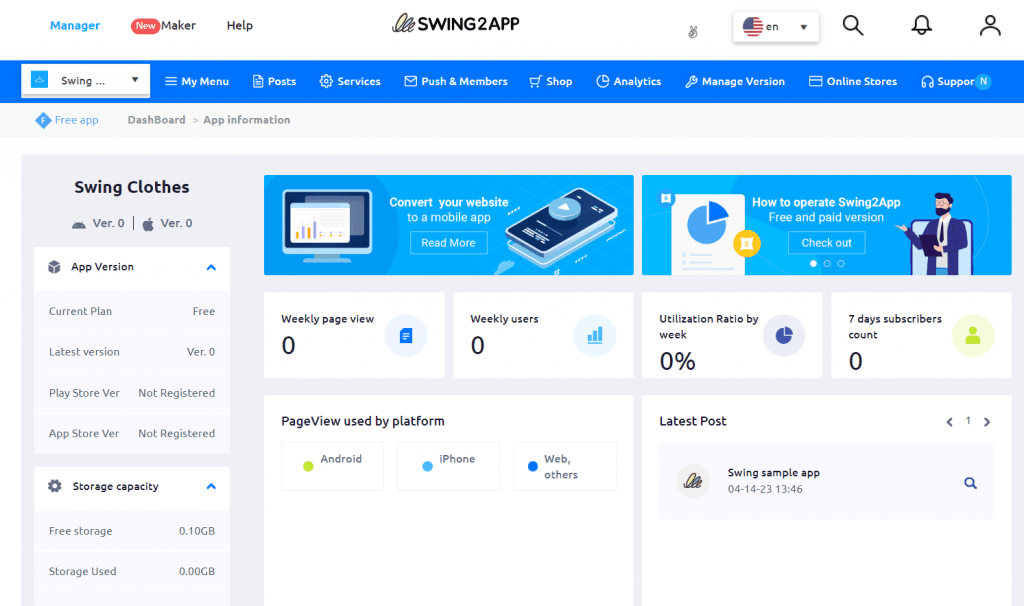
Swing2App analytics provides you with all the important insights about your application, which can be used to further enhance a part of the app or your app as a whole.
Swing2App analytics include:
User Pageview
All statistics can be viewed by selecting the desired period among 3 months, 1 month, and 1 week.
Number of Users: A statistic that counts the number of people using the app
Pageviews: A statistic that counts the number of times users have viewed a page within the app
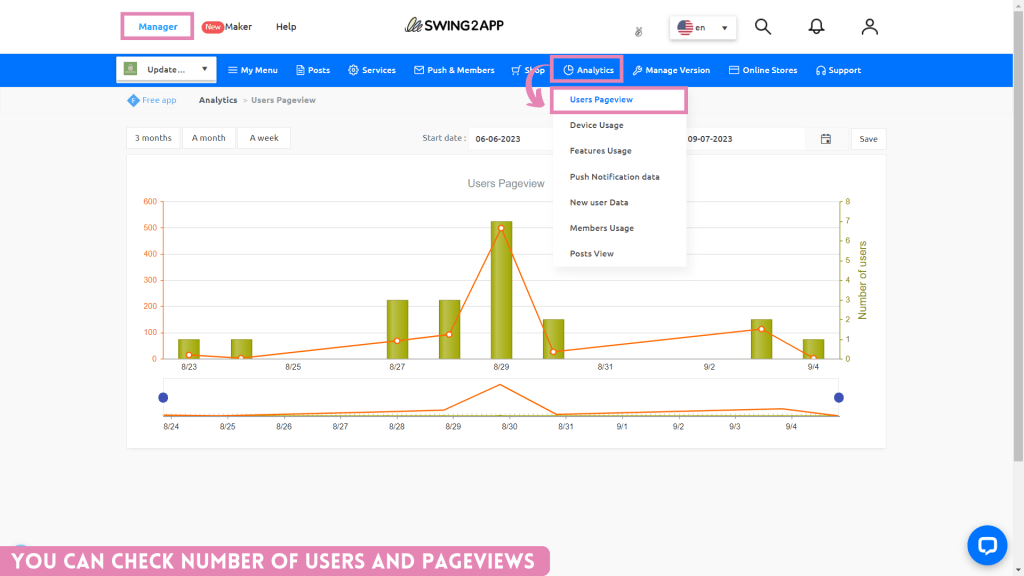
Device usage
Usage status by platform: You can check the usage status of each platform, Android and IOS.
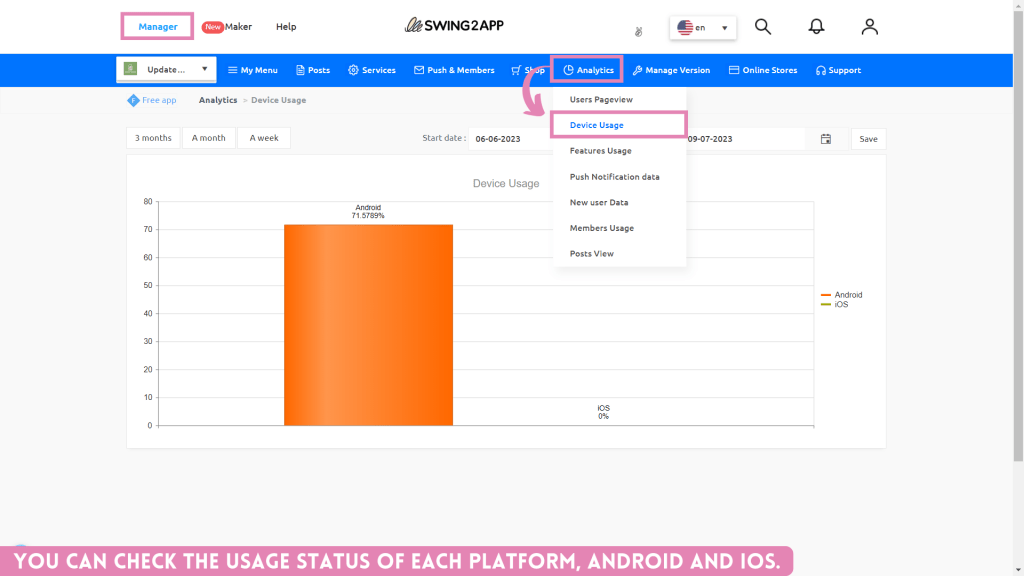
Features Usage
Usage statistics by feature: You can see which features users frequently use among the features provided by the app.
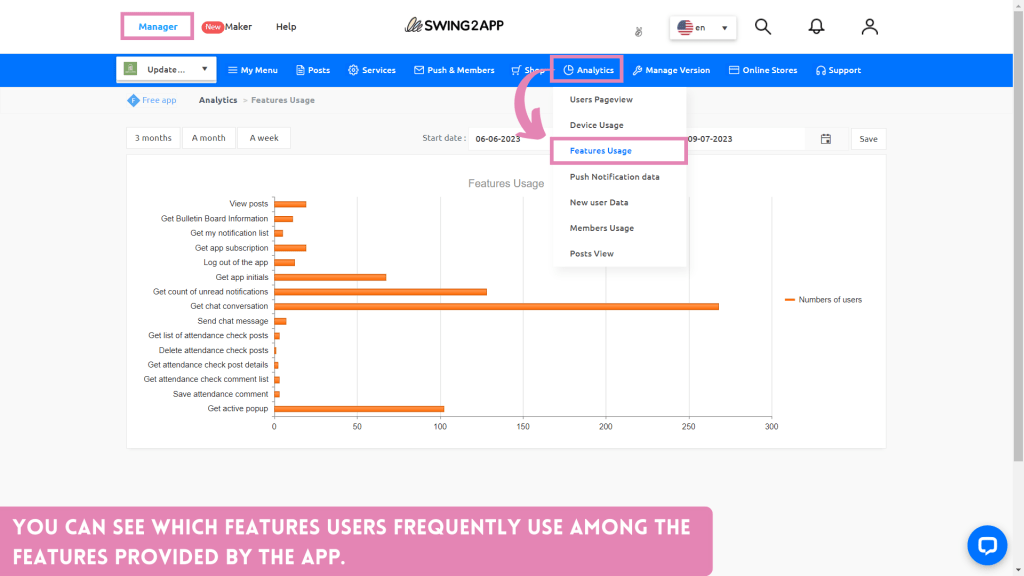
Push notification data
Push-sending status: If you send a push, you can check the sending status history of when and how many members you sent the push to.
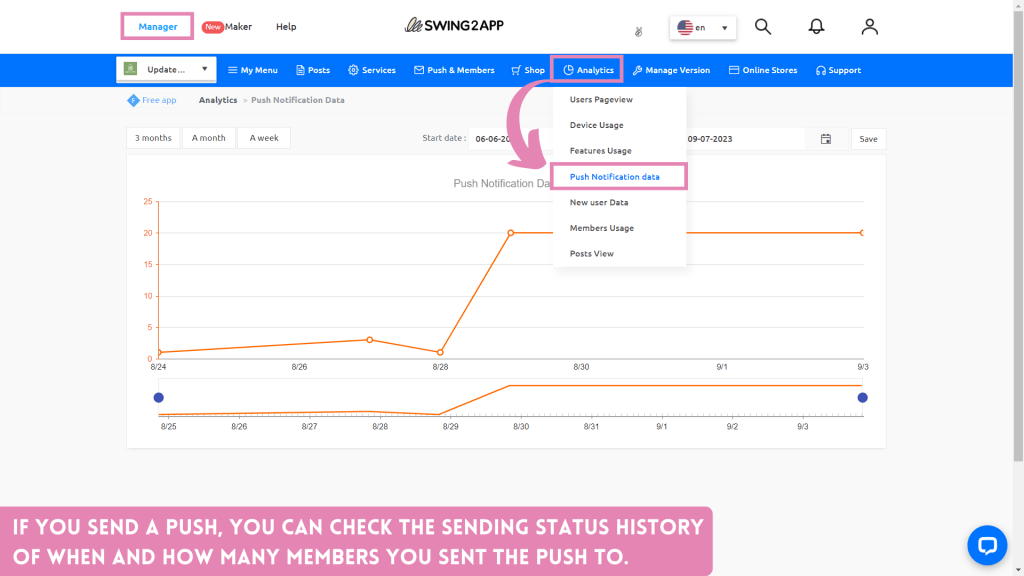
New-user data
Statistics to see the number of members who have signed up for the app. You can see when and how many members signed up for the app.
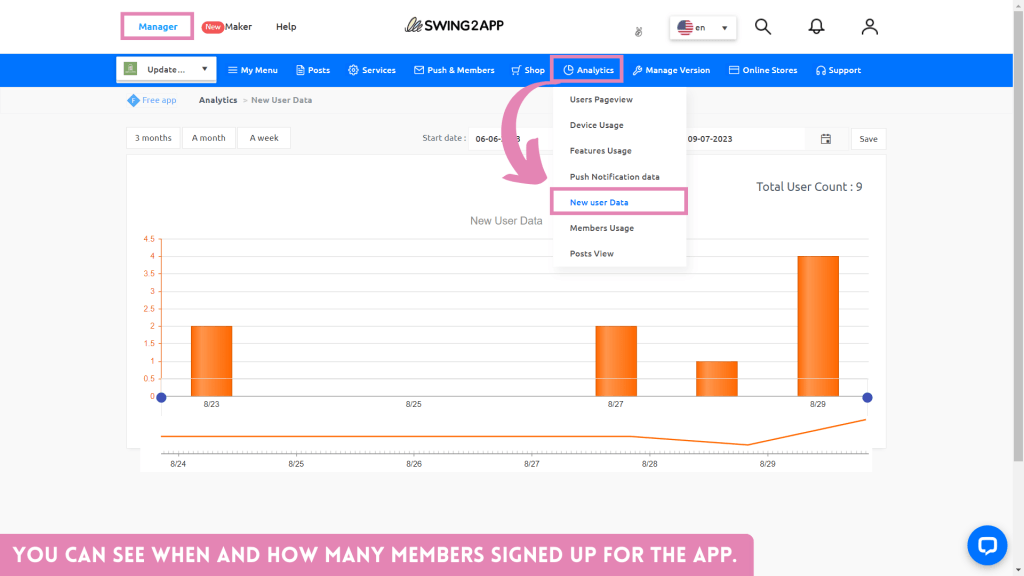
Members usage
Member usage statistics can check which members use the app the most, and information related to ratings or members.
The usage statistics for each member show the member’s name, usage index, subscription date, and level.
By setting the period shown at the top, you can check usage statistics for each member for the desired period.
Usage index tells the total number of times you use all the features of the app.

Post Views
The Post Views statistic is a statistical function that allows you to check which posts have the most ‘views’ and which posts have the most ‘likes’.
You can view posts by [views] and [likes] rank.
If you select the direction of the arrow in the Views, Likes, and Date area of the list, you can filter the views in descending or ascending order.
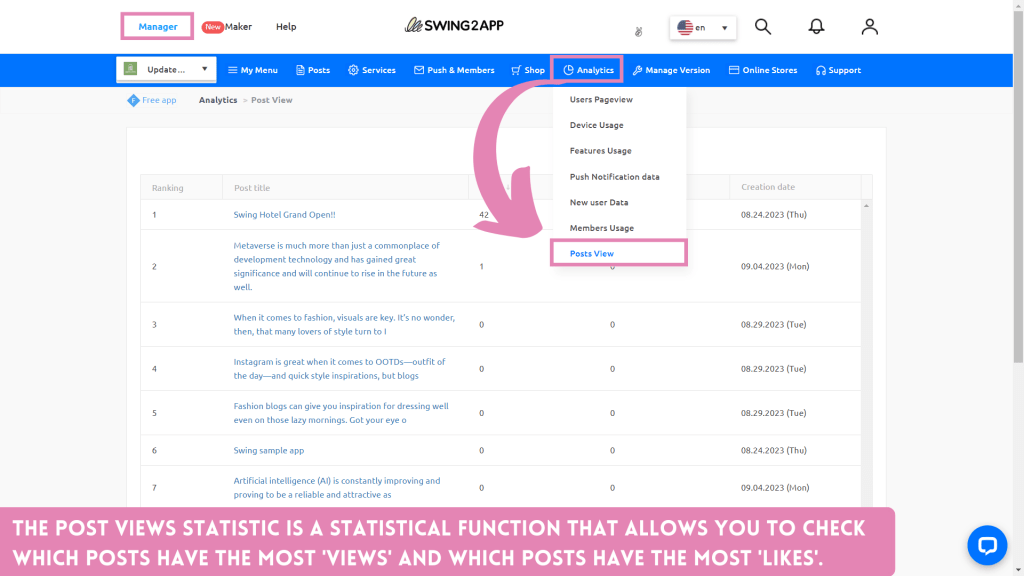
All these analytical insights can be used to determine if your app is going in the right direction or not. If you see declining trends in your app analytics just ask ChatGPT for solutions and implement them in your app with the no-code app-building mechanism of Swing2App.
For example, if your users don’t open the push notifications, you may ask ChatGPT for the reason and how to write an appealing push notification and thus get more user engagement.
You might be thinking, that changing push notifications might be easy but what about the app design or a page? Don’t worry with Swing2App no-code app builder you can easily edit your app in no time and that too without any coding.
The combination of Swing2App no-code app builder and ChatGPT generative AI fits perfectly for the needs of anyone looking to create an app by themselves.
Be the part of no-code and AI revolution and join Swing2App no-code app builder now!
]]>There is a lot of buzz about AI, some welcome it as a transforming tool while others think it’s scary!
The rise of low-code/no-code platforms allowing people without any technical background to make customized apps by simply selecting themes, designs, and features is definitely a game changer. Along with this, we have now various generative AI technologies like ChatGPT that can do complex coding in a fraction of the time. The knowledge of these tools has become essential for app developers as it can help them to make the app development process much more time-efficient.
With ChatGPT anyone can generate the code to create an app with complex features which will require a traditional app developer for days if not months, this is definitely exciting but scary for those who work in this industry, who might think of it as a danger to their jobs.
On the face, it might seem that the no-code/low-code technologies and AI are here to steal the jobs of traditional app developers, but that’s not the case because the demand for app creation is increased significantly. Further, to use these no-code/ low-code tools more efficiently you must have strong fundamentals. However, traditional app developers need to be well acquainted with these no-code/ low-code tech changes, so that they can speed up the app development process.
The demand for no-code/low-code platforms grew significantly during the Covid-19 pandemic when even small businesses were forced to create apps and launch their apps quickly.
However, now the game is even bigger with the entry of generative AI as it is going to transform the app development process inside out. The generative AI ChatGPT along with no-code/ low-code tools has created a new category of app developers known as citizen developers.
With the help of no-code/ low-code and ChatGPT-like technologies these citizen developers can build apps quickly and take their small businesses online in no time.
BENEFITS OF NO-CODE/LOW-CODE AND GENERATIVE AI CHATGPT
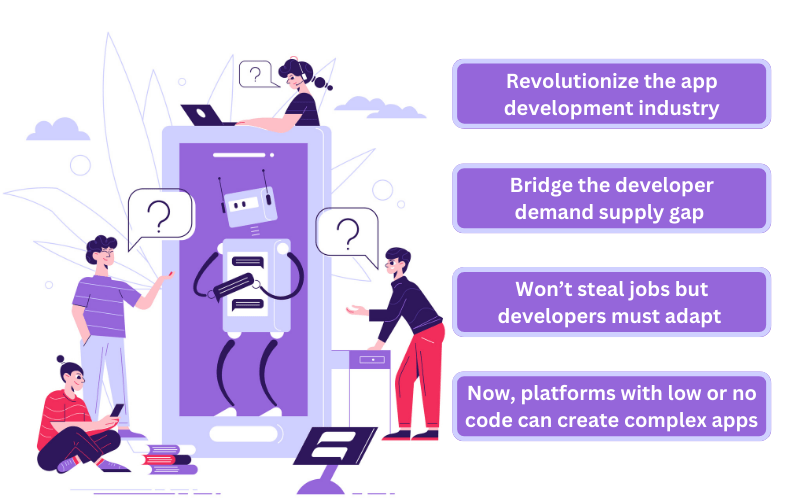
1. Revolutionize the app development industry
The confluence of generative AI ChatGPT and the no-code/ low-code tools has revolutionized the app development process and will bring more change in the future.
No-code/low-code platforms led to the rise of a new category of app developers– known as citizen developers. These budding citizen developers create apps by leveraging the visual interfaces and pre-built templates offered by the no-code/low-code platforms, which enable them to edit and build an app with minimal or no coding knowledge at all.
By empowering non-technical personnel to create apps for businesses, low-code/no-code platforms reduce the workload on technical personnel as well as make the app development process much faster and easier.
Now, converging these no-code/low-code tools with the generative AI ChatGPT further revolutionizes the app development process.
Generative AI enables you to make more informed and intelligent decisions as it provides large language models that are trained with transient data. ChatGPT can also assist you in coding and code reviews, generating test cases, and reviewing pull requests and other marketing documentation too.
Furthermore, if you are unable to understand a complex code, you can ask ChatGPT to simplify it and explain it to you. Isn’t it amazing? And the best part is that it is totally free!
The scope of the AI revolution isn’t limited to ChatGPT. DALL-E, a generative AI that produces designs and images takes the app development process to the next level. Creating an app design from scratch takes a long time, and this can be done much more quickly with the design generative AI, DALL-E.
Hence, as a mobile app developer, it is very important to be abreast with such generative AI and no-code/low/code tools.
2. Bridge the developer demand-supply gap
Traditional app developers knew coding apps were the only way to create an app, and they would usually end up charging you a lot of money and take months to create an app. This is not good news, especially for small businesses with tight budgets and constant pressure to create an app for their business to meet the current trends.
Due to the Covid-19 pandemic influencing digitalization, everyone has started building apps, whether a small business or a huge enterprise. This has resulted in a huge gap between the demand and supply of mobile app developers and has made the app development process even more costly. As a result, a vast majority of small businesses feel left out and face difficulties in creating even a simple app for their business.
However, with the emergence of technologies like ChatGPT, and no-code/low-code app development platforms the world of the app development industry has transformed significantly.
Automation, and technologies like ChatGPT, and no-code/low-code app development are the solutions to fill this supply-demand gap, otherwise, there’ll be thousands of left-out small businesses.
Swing2App no-code app builder is one such solution where anyone can create an app without any coding at all. Our mission is to help everyone whether a small business or an enterprise to create no-code apps in a cost-efficient and time-effective way.
4. Won’t steal jobs but developers must adapt
Many traditional app developers and analysts are worried about AI technology shrinking the traditional app developer job market, however, the future isn’t gloomy at all rather much bright. There are lots of opportunities for technical personnel, especially app developers. AI can never replace the human touch.
The trend of AI, no-code/ low-code tools will definitely change the apps as well as the skills required to create such apps, but the demand for app developers with strong fundamentals of coding will never get obsolete. Rather, these technologies will act as an up-skilling process for such traditional app developers to create apps in a more efficient way.
With the global focus on AI and no-code tech, traditional app developers must future-proof themselves by continuously updating their skills as per the latest industry standards.
To summarise, traditional app developers should buckle up and be well-versed in the fundamentals of computer science in addition to their tech stack. Perhaps most essential, people should exercise creativity in whatever they do. The no-code/low-code tech, and generative AI ChatGPT, all rely on your creativity; more creativity results in better outcomes.
5. Low/no-code platforms now are capable of creating complex functioning apps too
Traditional app development was expensive and required a long time to develop. However, this is no longer the case due to the UI problem being fixed by low-code/no-code platforms.
This implies that not everyone needs to be highly technical in order to understand and complete everything from the start, but rather they bring a unique set of values.
Automation eliminates much of the manual labor that would otherwise be necessary and improves security by lowering the possibility of human error.
If you enter a code snippet in ChatGPT and ask it where is it wrong or why is it not working, it will tell you the exact reasons in less than a minute. So, a task that usually took days for traditional app developers would become much easier with such generative AI technologies.
Now, you know about all the amazing benefits of no-code/ low-code tech along with generative AI ChatGPT. Let me introduce the Swing2App no-code app builder to you so that you can create an app for your small business much faster and in a pocket-friendly way.
SWING2APP: NO-CODE APP BUILDER CHANGING THE APP DEVELOPMENT PROCESS
Swing2App no-code app builder is a part of this changing landscape of coding and has evolved a lot over the past few years to provide no-coders with the best platform to create no-code apps.
If you have a unique web or mobile app idea that has the potential to revolutionize the web app business, we are always ready to assist you in realizing it. Everyone, especially small businesses can benefit a lot from no-code app builders like Swing2App. Our customized app development platform provides you with the best no-code technology stack for your needs and ensures that it is bug-free, high-performing, and user-friendly.
Together, let’s build the no-code apps of tomorrow!
BENEFITS OF SWING2APP NO-CODE APP BUILDER:

Citizen development: Swing2App aims to help every small business, entrepreneur, and non-technical people to create apps. Pre-built app templates provide a basic outline to citizen developers, these can be easily edited as per the imagination and creativity of the user.
Entirely no-code solution: Everything from app prototype, theme, template, and features to actual app release is based on no-code technology. You don’t need any coding experience at all to create an app for your small business. However, if you wish to add some customized features you can code them in the HTML editor provided by Swing2App no-code app builder.
Create all kinds of apps( web app, android, iOS): With Swing2App no-code app builder you can convert your small business website into an app in less than 5 minutes and enjoy the features like app theme, toolbar, push notification, app features and much more.
You have created just a single app for both the iOS as well as Android platforms, thus creating 2 apps at the cost of one!
Pre-built features( calendar, maps, chat, share, etc.): Swing2App no-code app builder provides many pre-built essential and industry-specific features for your app. All you have to do is to assign a feature to a particular menu option and name it, without writing even a single line of code.
For example, if you want to create an e-commerce app you get pre-built features like product category, product list, My cart, Order details, Wishlist, search bar, and all other essential e-commerce app features.
Create a compliant app (app store laws): With Swing2App no-code app builder any app created is totally compliant with both the Appstore as well as Play Store. Hence, you can be well assured that your app won’t be rejected.
Don’t rely on costly traditional app developers when Swing2App no-code app builder offers everything at a reasonable pocket-friendly price.
CONCLUSION
The swift rise of low-code and no-code platforms has caused a major shift in the way software is developed. Furthermore, the entry of generative AI like ChatGPT and DALL-E has given additional thrust to citizen development.
According to market analysts, this market will grow significantly over the next five years, more than doubling, and is predicted to reach a staggering $187 billion by 2030. These platforms offer unmatched benefits, such as accelerated software development timelines and improved cross-collaboration between IT and business teams. They can speed up software development by up to six times.
Don’t miss out on the global app development revolution, visit Swing2App now to be a part of the no-code revolution and boost your small business.
]]>We have compiled a list of the ten best mobile app ideas for small businesses that will be profitable in 2023.
In the Apple App Store and Google Play, there are millions of mobile applications available. It’s because new businesses want to employ the newest advertising technology to reach their target audiences. As a small business or a new startup, you must also think about app development as an extension of your business model.
As consumers depend on their smartphones for everything, the app development industry is flooded with many choices. So, what should you do? Million-dollar app idea needs a lot of brainstorming which is quite challenging. Today, we’ll assist you in answering this issue by preparing a list of top small business opportunity application ideas for 2023. Let’s get started!
Hope you discover the best app idea to build your app!

1. Unexplored app ideas for Small Businesses
Tutorial App on Video Creation and Editing
Making films is a new popular activity among teenagers and even adults: in the age of YouTube and TikTok, people are eager to create engaging and inspirational videos with as much imagination as they can. Some people transform their pastime into a full-time profession that allows them to earn decent money. However, the market for video editors currently lacks a comprehensive training tool that could be used by both beginners and experts, as well as specialised tutorial applications for certain areas of video creation that might teach users how to record, trim, process, edit, and upload their movies more effectively.
AR App for Clothes Shopping and Fitting-on
The top app development idea of creating an app that could immensely help customers to make their choice has been in use for many years. Customers, however, did not receive the Uber-like experience: easy, attractive, and adaptable. Customers want an app that offers excellent usability, a 360-degree viewing angle, fitting, changing, combining with other personal garments, online ordering, and smart e-payments. If any small business succeeds in developing one, it will undoubtedly revolutionize the shopping experience and the whole eCommerce market forever.
Pet and Animals Care App
Pets are no longer regarded as mere living beings; they have long since become our buddies and family members. People now care for them even more, giving them with the greatest meals, medication, and enjoyment they can. However, in today’s fast-paced world, it can be difficult to remember and handle all these chores. That’s when a pet care app might come in handy. It might combine the purchase of food, cosmetics, veterinary goods, and care under one roof, saving users time and money.
2. Small Business Fintech & Payroll Apps
Investment and Trading App
Trading and investment solutions are becoming increasingly popular as consumers want to learn more about markets, assets, stocks, and funds, as well as how to profit from this information. A trustworthy digital banking software that could monitor people’s bank accounts and automatically put funds into the most advantageous shares, perform other daily financial activities, and track total expenditure would be one of the top app development ideas in 2023.
Digital Insurance App
Digital insurance of personal banking savings is not as simple as it appears at first glance. The answer is simple: this sector has a massive quantity of legacy apps. It would be ideal if your solution included real-time data, risk management, personalized suggestions, and offers to provide clients with a convenient approach to protect their assets.
Money Saving App
As time passes, it becomes more difficult to keep track of personal expenditures and manage one’s budget. The app development industry is ready to help its consumers with this task: various money-saving and accountancy apps are already in use. However, they are not perfect: some cannot receive data from other programs, some have difficulty reading SMS (Short Messaging Services), and so on. Developing a stable and user-friendly solution that can suit the demands of all clients is undoubtedly one of the top app development ideas for 2023.
3. Scheduling Apps for Small Business
Productivity and Scheduling App
For organisations of all sizes, optimising staff workflow and efficiency is priority number one. Digital solutions in this industry enable the automation of many manual processes, the elimination of unneeded ones, and improved resource allocation, saving a firm time and money. The same is true for scheduling apps: they allow you to automatically assign work to team members and measure their productivity, as well as ease cooperation across departments and enhance the overall KPIs of the organisation. Productivity or a time clock app for small business can be a great app development idea in 2023.
Accounting App
With the advent of the digital era, physical accounting books, manual entry of ledger information, and time-consuming paperwork have all but vanished. The app development industry now provides a plethora of accounting and inventory programmes for small businesses to select from. A suitable application to launch next year will be one that can harness both current technology and industry experience, give informative visual analytics, and have backup and recovery capabilities.
Cloud storage app
Cloud technology is reaching its pinnacle right now, with increased businesses transferring their assets to one or more cloud providers. Customers favour this kind of data storage because of features such as zero-knowledge encryption, setting expiration dates, and unrestricted accessibility and scalability. Small businesses that opt to develop an app with enhanced security and performance will undoubtedly profit.
4. Travelling App Ideas
Voice Recognition and Translation App
When traveling, people often run into language barriers, yet they do not have the time to translate what is spoken. It generates misconceptions and adds to the challenges of the journey. A simple language translation app with voice recognition that supports several languages might overcome this difficulty and allow many people to travel more easily and comfortably.
Packing and Moving Services App
Moving to a different place to live isn’t unusual, but rather a common scenario in modern life. However, packing and shipping all these items and furniture is usually a difficult undertaking. App development companies are already trying to help individuals in resolving the problem by providing user-friendly all-in-one platforms with a variety of transportation alternatives and services to pick from.
Virtual Travel App with VR (Virtual Reality) Technology
People were unable to travel during the Covid-19 pandemic, and it was at this period that virtual travel began to take off. Online sightseeing, galleries, museums, and even concerts are just a few of the virtual travel services that the current lifestyle app sector can provide. Customers are now searching for an ultimate Airbnb-like solution that allows them to select any place or sight they wish to see and feel as if they are physically travelling to that location.
5. App Ideas for the Food Industry
AI-based Food and Beverages Ordering App
Isn’t buying meals and groceries every week a time-consuming task? Statistics prove that over sixty percent of Americans prefer takeout or delivery of their food more than once a week. The worldwide online grocery industry is expected to increase fivefold to $42830 million by the end of 2027, signalling that it is past time for supermarkets to consider opening an online grocery shop.
AI-Based Restaurant Booking App
Restaurant owners often face the challenge of losing customers owing to a shortage of workers who can answer all calls and make bookings on time. AI-powered virtual assistants might fix this issue and free up people time for other work. People want an app that can advise on the menu and specialties, reserve a table, and send special remarks to the administration if a customer has specific culinary preferences or diet.
Restaurant Management App
The restaurant industry is thriving during the post-covid recovery, and owners are looking for methods to improve workflow and management at their establishments. Remote monitoring systems and scheduling apps may be able to help them in achieving this goal: improved insights, real-time data, and enhanced staff efficiency are just a few of the advantages that such applications provide for organisations.
6. Small Business On-Demand & Scheduling Apps: Household Services
Car Services App
Regular maintenance and technical examination of any vehicle necessitate not only time but also knowledge of which services or suppliers are most suited to a certain vehicle type. It might be difficult to find the answer to this question. A customisable automobile online site featuring all automotive services like washing, cleaning, repairing, detailing, and so on, as well to track consumer feedback on the quality of these services, might be a genuine game changer in this industry.
Household Services Ordering App
This type of app might organize all housekeeping services and suppliers on a single platform based on their popularity, reviews, and budget level. As a result, consumers can order and even plan whatever they need to do around their homes, from dusting and cleaning to mowing and landscaping, all in one spot, saving time, effort, and money.
Beauty Salon Appointment Booking App
As the beauty sector has developed dramatically, with an overwhelming number of services and items to order, this is one of the greatest app development ideas to create in the future year. However, a user-friendly and strong customisable platform that might save women’s time for all these operations is currently absent. To increase profits, small companies might partner with beauty service providers to offer their customers exceptional discounts when ordering multiple or repeat operations.
7. Small Business Fintech Apps: Cryptocurrency
Crypto Exchange Platform
People’s interest in cryptocurrencies and the profits they might provide grows year after year. Millions of individuals are attempting to make money online through various cryptocurrency exchangers, but few of these services are trustworthy owing to a complex user interface and ambiguous exchange regulations. As a result, the cryptocurrency market needs a brand-new transparent and user-friendly platform that can fix these issues and help to establish trust in cryptocurrencies and a decentralised financial system in general.
Blockchain Banking App
The finance and banking industries are among the most vulnerable to fraud, with hackers all over the world continually attempting to steal clients’ financial data via different cyber assaults. Blockchain is a fantastic technology that, owing to its decentralised method of storing client data, allows for the abolition of this problem. Creating a completely customizable financial services solution using this technology is undoubtedly one of the best app ideas in 2023.
Digital Wallet App
Digital wallets, such as PayPal, are becoming increasingly popular since they are far more handy than having actual cash or even cards in the wallet. According to experts, the worldwide e-wallet industry would reach $7,582 billion by the end of 2024. While it’s difficult to compete against giants like Apple Pay or Google Pay, developing a payment app is one of the best app ideas for small business in the coming year.
8. Small business services app
Digital CV/Resume App
Digital CV/Resume tool that allows you to make and save a digital copy of your professional resume. Each resume will be assigned a distinct Identification number.
While looking for a new job, you can share your CV number with potential companies. Companies may then access your online profile using the app.
Private Tutor App
Most students had to take classes from home throughout the pandemic due to isolation precautions. This resulted in an increase in the demand for e-learning apps beginning in March 2020, and the demand does not appear to be decreasing anytime soon. The market is now growing at a 21% annual rate and is predicted to cross $1 trillion by 2027.
Astrology app
This industry is also not much explored and there is limited competition as well. If small businesses like tarot card readers, or fortune tellers want to increase their reach, creating such an app is the best app development idea in 2023.
9. Location-based apps
Nearby EV Charging Station Finder App
The vehicles, like time, have undergone changes. The Nearby EV charging station search app’s goal is to target all people who own electric vehicles. The app will let customers locate an EV charging station in their immediate vicinity.
Top food outlets suggesting app
Creating an app that tells users about the nearby food-outlets is another top app development idea. As it provides a brilliant solution to the time crunch issues of the present generation, as they can view the nearby outlets on their fingertips.
Parking finding apps
With the ever-growing urbanization, parking has become a genuine problem is various countries. By creating an app that solves a key problem of your target audience; you can surely earn a lot.
10. Health apps
Health tracker
With the tight schedules and fast pacing modern life, health has taken a backseat. This is a grave issue all over the globe, and thus providing a solution by creating an app for tracking health issues will ben you as well as your users.
Ayurveda app
Another top app idea for 2023 is to create an app for creating awareness about Ayurveda or Yoga. You may create a simple video-based teaching app or e-commerce app selling herbal products too.
Healthy lifestyle teaching app
Health is wealth! This idea will create wealth for you and your customers as well. Post Covid people have been facing lots of physical and mental illness due to sudden change in their lifestyle. Creating Healthy lifestyle app would truly be one of the best app development ideas.
WHAT’S NEXT: CREATE A FREE NO-CODE APP WITH SWING2APP
If you have a unique web or mobile app idea that has the potential to revolutionize the web app business, we are always ready to assist you in realizing it. Our customized app development platform provides you with the best no-technology stack for your needs, and ensures that it is bug-free, high-performing, and user-friendly.
Together, let’s build the no-code apps of tomorrow!
]]>Perhaps you want to incorporate citizen development into your organization. Maybe you’re just curious about the subject.
With companies constantly undergoing digital transformation, IT teams are under intense pressure, resulting in IT backlogs. This is where citizen development can help.
Citizen-led development has been adopted by businesses all over the world because it provides non-IT experts with the necessary technology and IT support to create the basic apps they require. Employees who create their own apps work more efficiently, reduce the company’s operating costs, and reduce the IT backlog.
We’ll cover everything you need to know about citizen development in this guide, including a simple definition, pros and cons, examples, and necessary technology.
Let’s start with the basics.
WHAT IS CITIZEN DEVELOPMENT?
Citizen development is defined as the process by which non-IT-trained employees become software developers by building business-critical applications using low-code/no-code (LCNC) platforms. It can be also put as IT-sanctioned and approved applications created through citizen development methods.
This distinguishes the concept of citizen development from shadow IT. Citizen developers are non-IT experts who seek solutions to their specific problems and use low-code/no-code platforms to create them.

Any non-developer (regular user) who can use no-code platforms to build a specific business app is referred to as a citizen developer.
No-code application development is not a new practice; in fact, most major SaaS platforms have been using this model for quite some time. But it has certainly grown in popularity in recent years.
According to Gartner, no-code or low-code platforms are used to create technology solutions by 4 out of 10 non-IT employees on average. According to the same study, the global no-code market will be worth $13.8 billion in 2021, a 22.6% increase over last year.
As digital agility improves, more employees are becoming citizen developers, developing applications on their own. Citizen developers can be found in departments such as human resources, research and development, finance, and customer service.
WHAT ARE NO-CODE DEVELOPMENT PLATFORMS?
No-code development is the process of creating software using visual models rather than code.
Rather than writing lines of code, you simply drag and drop various elements.
This is made possible by a concept known as “abstraction.”
Abstraction takes away the complex nature of writing code from scratch and replaces it with pre-built “code snippets” that you can use to build the app solution you desire.
No-code development provides a user-friendly interface to select and place options, themes, and menus of apps without writing even a single line of coding. The app can be viewed on The Preview screen, and you can edit your app visually quite easily.
WHAT DOES A CITIZEN DEVELOPER DO?
With the help of IT, citizen developers create applications to solve business problems. They use no-code and low-code app development tools to create new business applications for themselves and other employees to use. They have a thorough understanding of an organization’s or department’s processes, as well as advanced digital skills. This enables them to easily create efficient business apps and automate workflows using citizen automation.
Source: Gartner
Citizen developers are distinct from professional developers who build solutions with pro code. Pro code platforms rely solely on code, whereas no-code systems employ a graphical user interface that enables users to create apps without coding.
THE PROS AND CONS OF CITIZEN DEVELOPMENT
Citizen development is a powerful concept that has the potential to transform your business for the better.
However, it is not without flaws.
So, now that you understand the fundamentals of this model, let’s look at some of the advantages and disadvantages of the process.
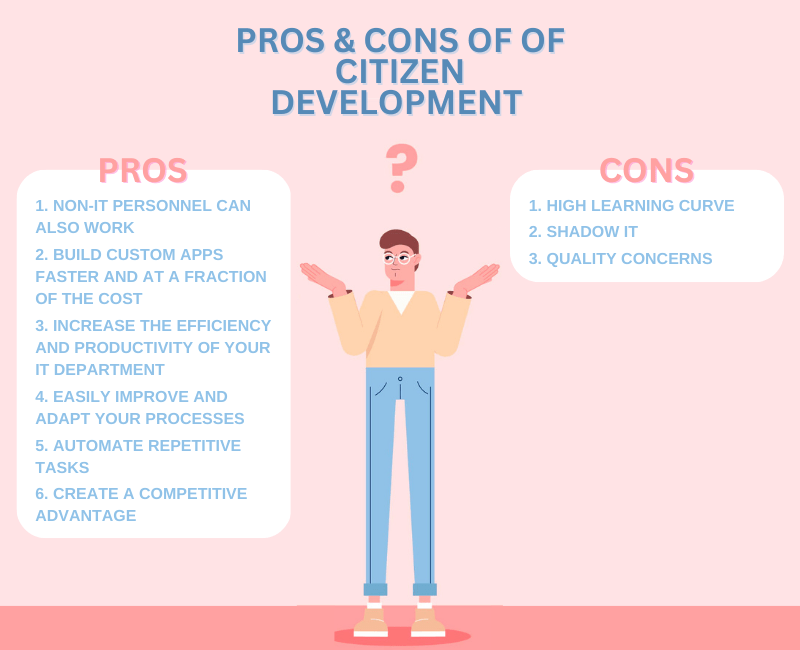
PROS of Citizen Development
Some of the primary advantages of citizen development include:
Non-IT personnel can also work: This helps to bring more creative ideas to the table, reduces the workload of the IT department, and thus increases productivity.
Build custom apps faster and at a fraction of the cost: citizen developers can create a new application in days, not months, which can drastically reduce your development costs.
Increase the efficiency and productivity of your IT department: No-code platforms, when properly implemented, can improve collaboration between IT professionals and non-devs.
Easily improve and adapt your processes: no-code technology enables anyone in your organisation to identify opportunities for improvement and build a solution on their own.
Automate repetitive tasks: artificial intelligence helps you in automating repetitive processes and reuse that time into more productive initiatives, which goes hand in hand with citizen development.
Create a competitive advantage: quickly adapting to constantly changing situations can become a true business advantage.
CONS of Citizen Development
Some of the disadvantages of citizen development include:
High Learning curve: While citizen development is simpler than traditional development, you must train your employees on how to use no-code development platforms.
Shadow IT: Because almost anyone can create a custom app, your IT department may lose control of some development processes.
Quality concerns: developing so many new business applications in such a short period of time can result in low-quality development.
The good news is that all of these issues can be easily avoided by following the proper procedures.
WHY DO YOU NEED CITIZEN DEVELOPMENT IN AN ORGANIZATION?
Most organizations’ IT departments have such a large backlog of work that they are unable to respond to new requests quickly. They are overwhelmed by an endless stream of requests, and keeping up is impossible. This is where citizen-led development comes into play.
- 71% of business leaders believe that IT teams are ignoring a large number of new solution requests.
- According to 451 Research, integrating low-code/no-code tools can increase development efficiency by 50%-90%.
- 41% of those polled have active citizen development programmes, with another 20% planning to start one.
- The number of citizen developers would be four times that of professional developers by 2023.
- Based on a Gartner report many organizations have active or planned citizen development strategies.
A few key principles underpin citizen development:
- A streamlined app development process: using visual elements to create custom technology solutions.
- Data access: non-developers (non-devs) have access to organizational data, allowing them to design solutions to problems more quickly.
- Process optimization: using workflows and standardization to digitize and optimize business processes.
- Work centralization: the removal of gaps between IT and the rest of the process in order to maximize cooperation and innovate faster, and more frequently.
These principles make it easier for modern organizations to deal with the constantly changing environment.
The concept of a “citizen developer” arose to address this issue and provide all employees with the ability to create their own solutions without the assistance of an IT professional. This does not imply that IT is no longer relevant, but rather the opposite.
Citizen development bridges the gap between IT and your other departments, allowing them to collaborate more quickly, optimize more frequently, and solve problems more efficiently.
PROFESSIONAL DEVELOPER VS. CITIZEN DEVELOPER
| Traditional development | Citizen development | |
| Code | Pro-code | No-code |
| Ease of use | Much difficult for non-tech staff | Anyone can make apps |
| Speed of app launch | Long process | Quick-to-launch apps |
| App Development Cost | $40K to $250K+ | <$10k |
| IT Involvement | High | Minimal |
| Primary Focus | Technology management | Business automation and productivity enhancement |
Citizen development emerged from business analysts’ realizations that professional developers were given far too much responsibility, as they were expected to create applications as well as troubleshoot existing ones. Because these IT professionals had a backlog of queries from various departments, projects would sit in their queue for months.
Rather, LCNC (Low-code/ No-code) platforms now allow employees with no professional development experience – known as citizen developers – to create applications for their co-workers and customers.
Since citizen developers are much more likely to be well-versed in their area of expertise than professional developers, applications created and updated by citizen developers — closely supervised by professional IT developers — are much more likely to cater to the needs of users who are either part of the citizen development community or benefit from their expertise.
Citizen development is here to stay and will play an increasingly important role in application development. Businesses today must strike a balance between the speed and suitability of citizen developers’ targeted creations and the security and oversight provided by professional developers.
WHAT SKILLS ARE REQUIRED FOR A CITIZEN DEVELOPER?
Here are four essential skills that business users must have in order to build an effective citizen development model:
Complete understanding of business operations:
To create effective business apps, a citizen developer must be well-versed in various business processes, as well as their inefficiencies and bottlenecks. This will assist them in analyzing and developing the appropriate processes and apps that are aligned with their organization’s goals.
Enhanced digital skills:
To ensure a long-term citizen development framework, a thorough understanding of business processes should be combined with advanced digital skills. Process analytics, document creation, and no-code bot automation are all examples of skills required.
Capability to collaborate across departments:
One of the primary goals of low-code and no-code platforms is to maximize citizen developers across departments. In such a case, a citizen developer must serve as a bridge, ensuring flawless cooperation between business and IT in order to achieve organizational goals as a whole.
Motivated to learn new skills:
The concept of citizen development has recently gained traction, making way for the digital revolution. In that case, motivation to upskill is critical, and business users must be willing to invest time to self-educate and master the no-code skills.
WHAT DO YOU NEED TO BE A SUCCESSFUL CITIZEN DEVELOPER?
You must understand a few key concepts to get the most out of citizen development.
Let’s analyse them.
1. Recognize the importance of software in today’s organizations.
Whether you’re a marketing agency, an eCommerce company, or a SaaS provider, the software is a critical component of your business.
The majority of your operations are carried out in and through software.
You’ll eventually reach a breaking point if you don’t have a quick and dependable way to manage, optimize, and improve all of the software processes involved in your business.
The first thing you should understand is that citizen development is no longer a luxury for modern organizations, but rather a necessity.
2. Use the appropriate no-code development platform.
Many platforms assert to be no-code when in fact they are not.
You can certainly move some elements around by dragging and dropping them, but that’s pretty much it. To get the most out of citizen development, look for a platform that completely immerses you in a no-code experience.
So, how does a real-world no-code platform look?
As an example, consider Swing2App.
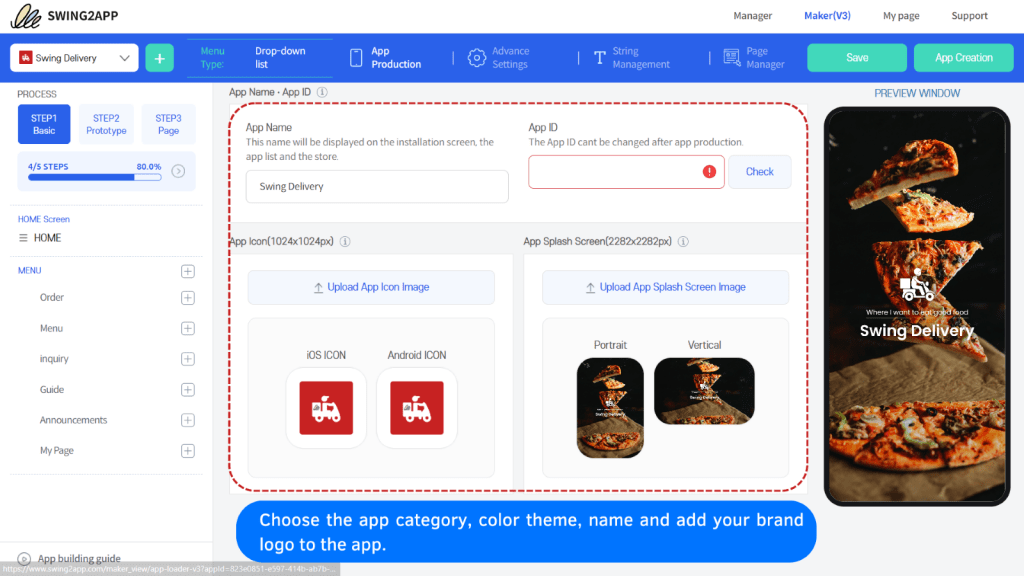


WHY IS SWING2APP THE BEST NO-CODE TOOL FOR CITIZEN DEVELOPERS?
Most companies’ IT departments are overburdened. They have a massive backlog, and new requests for solutions never seem to stop coming in. That is why it is critical to empower citizen developers. They claim to have a solution for both budget and staffing issues, and all they need is a good no-code platform.
Swing2App’s citizen development platform is a simple work platform that will help you become a citizen developer quickly. It does not require extensive restructuring to use and contains a plethora of excellent tools that are simple to grasp. Sign up for a free trial today to get started building apps on a budget.
]]>